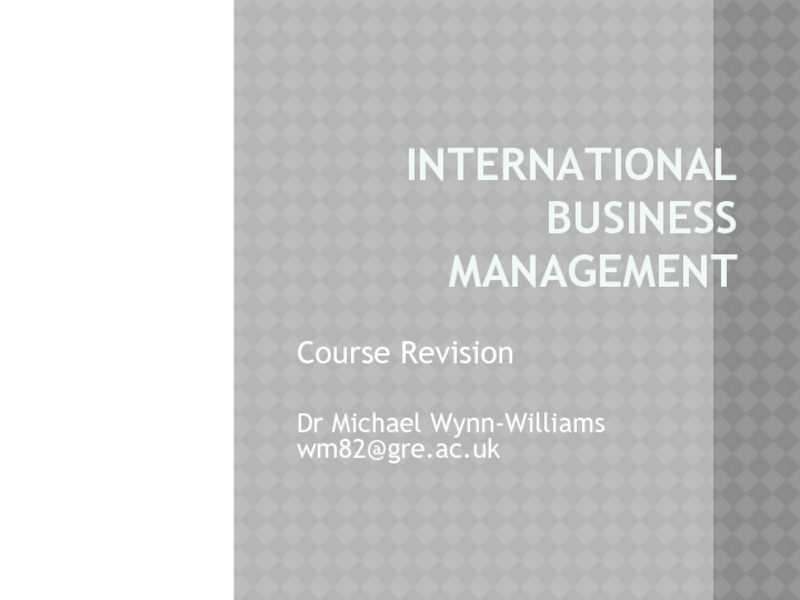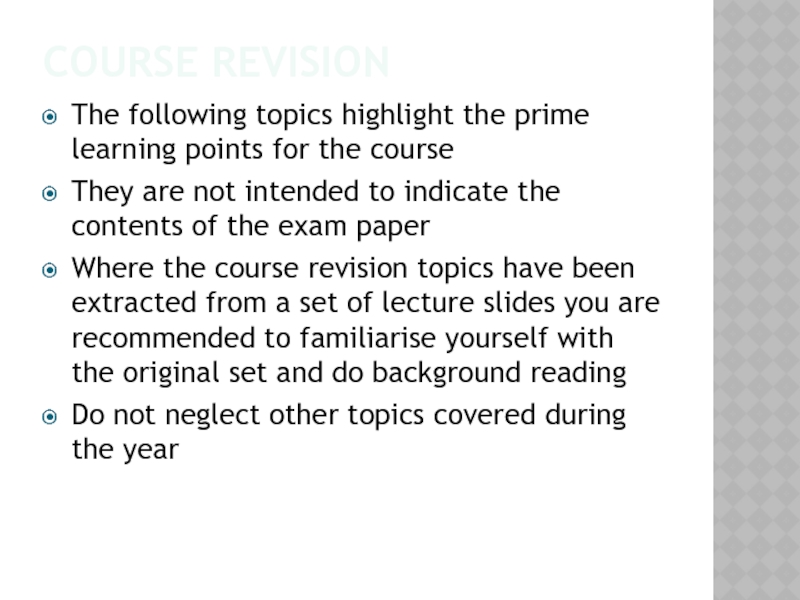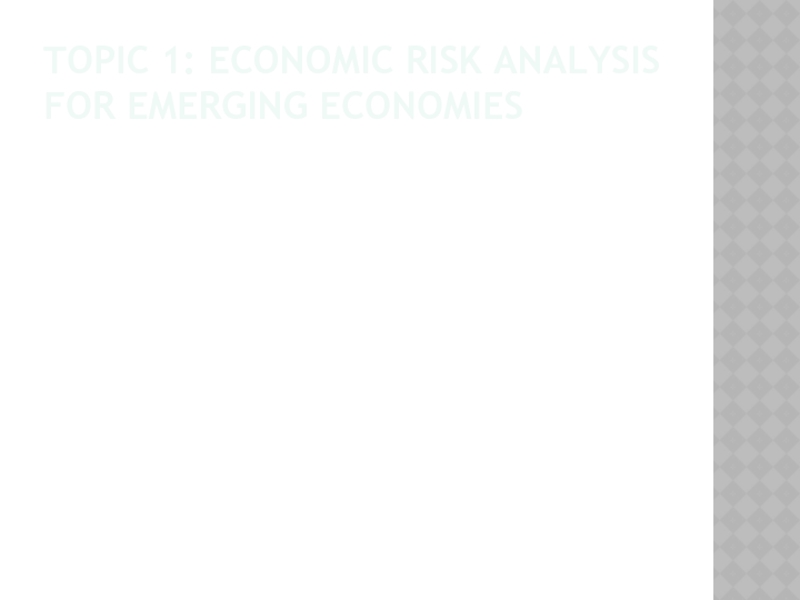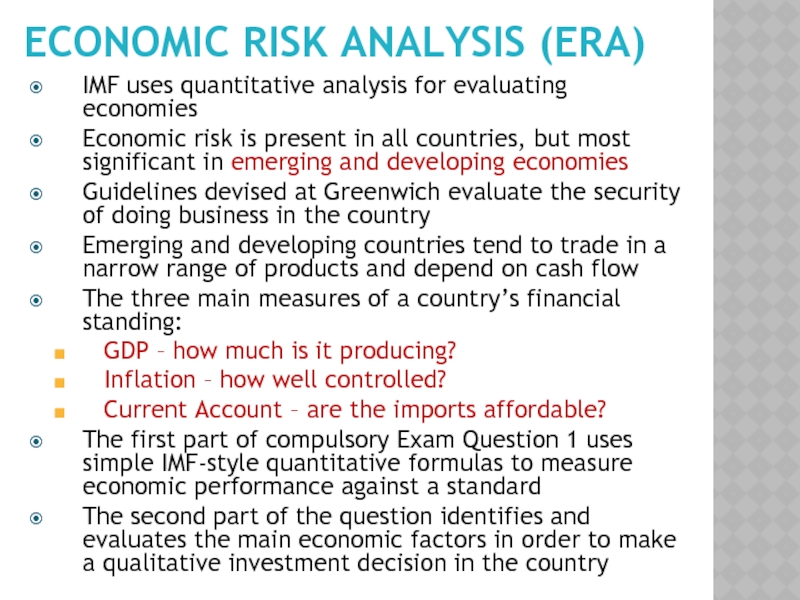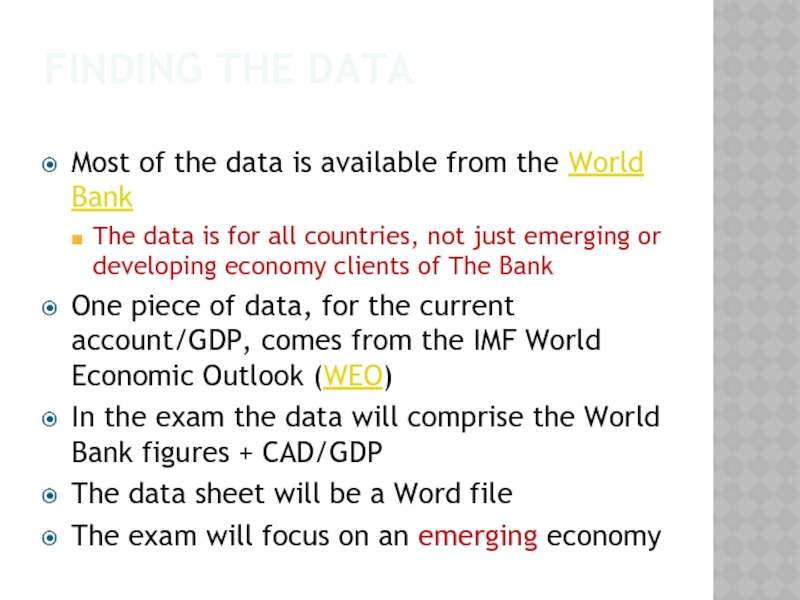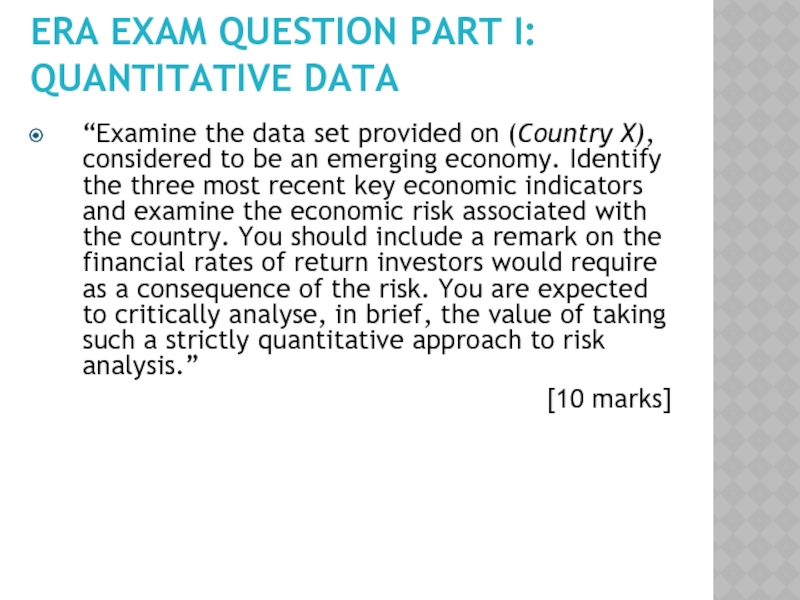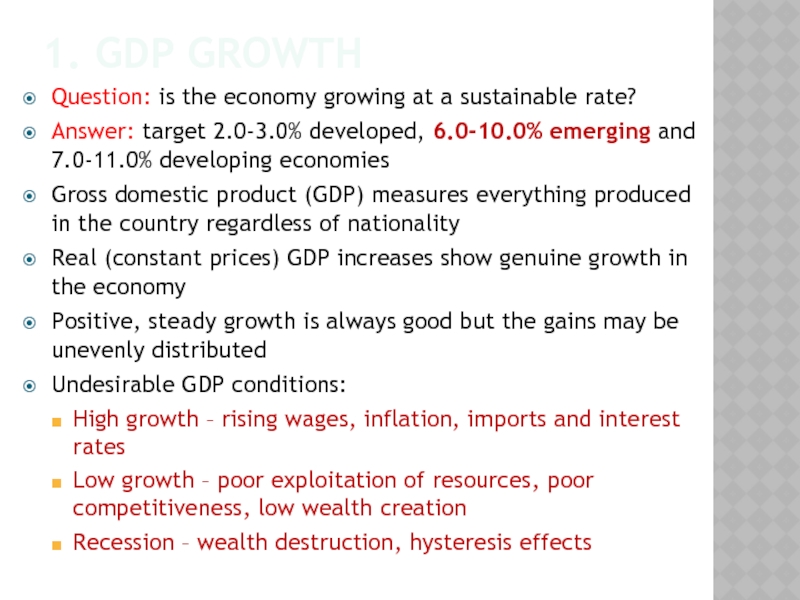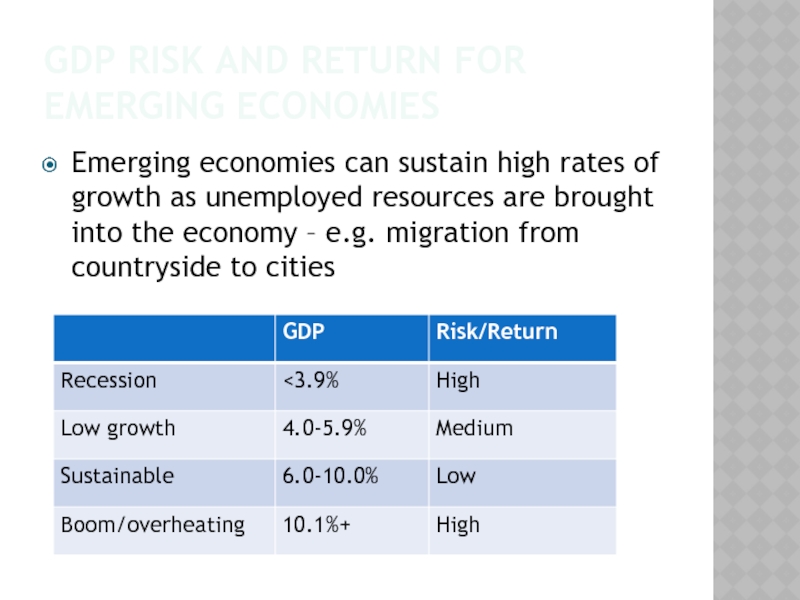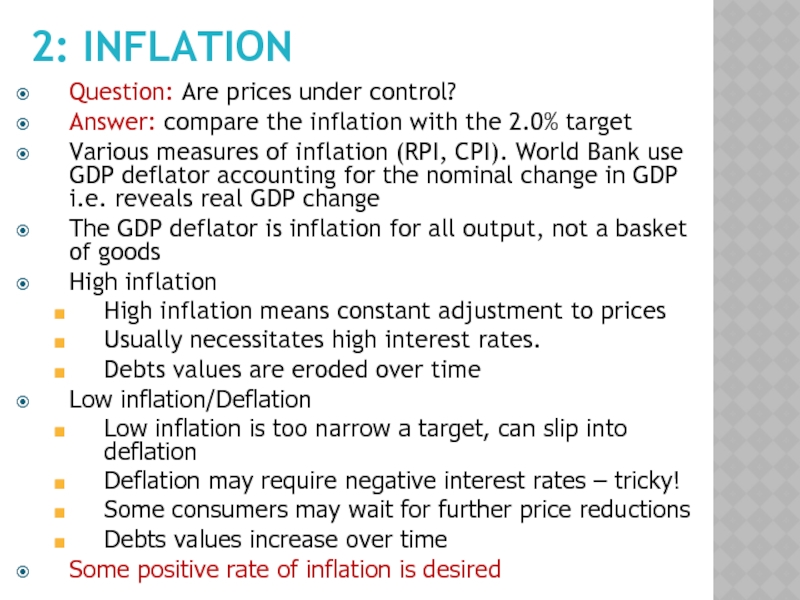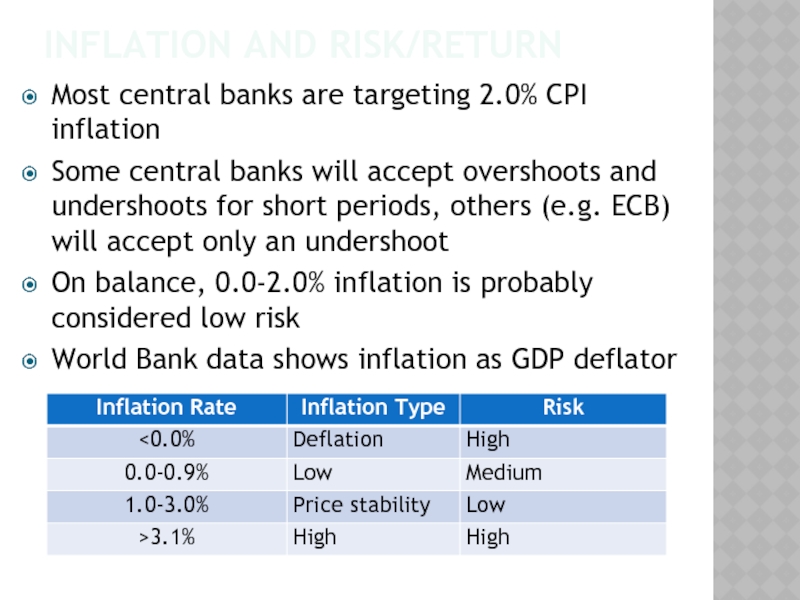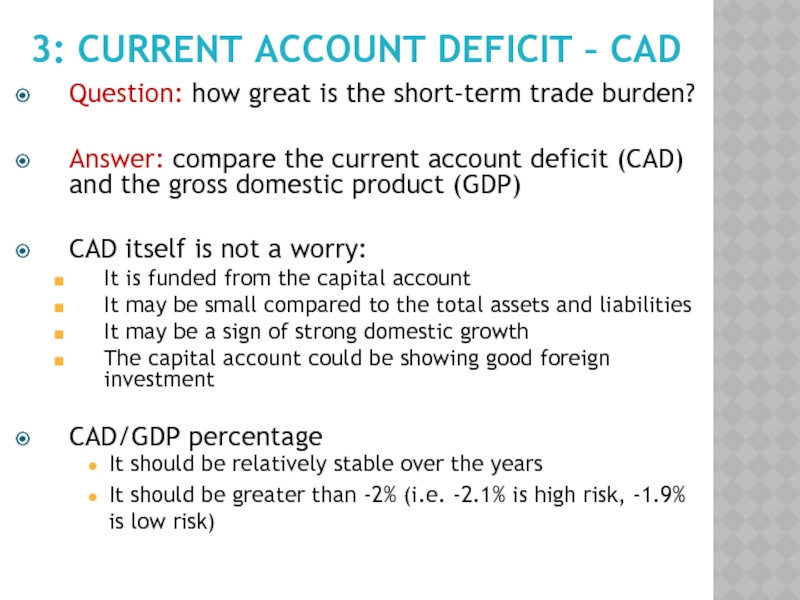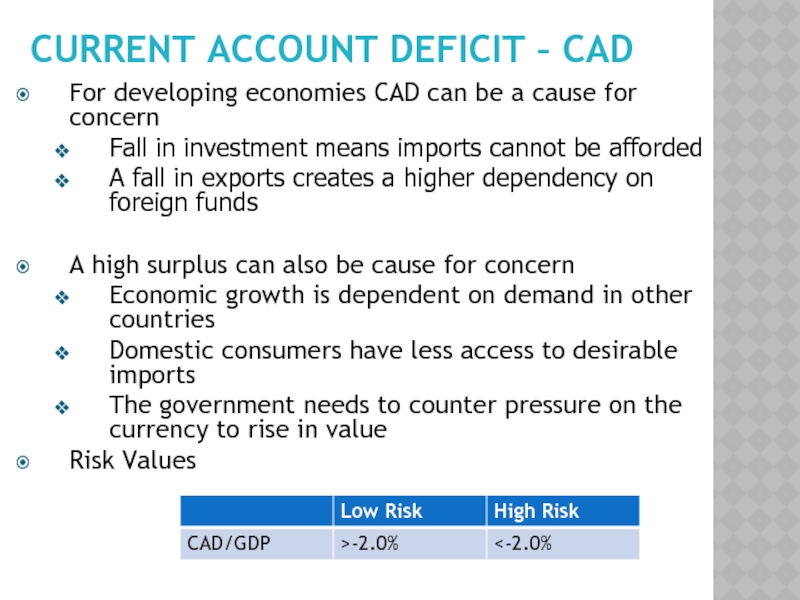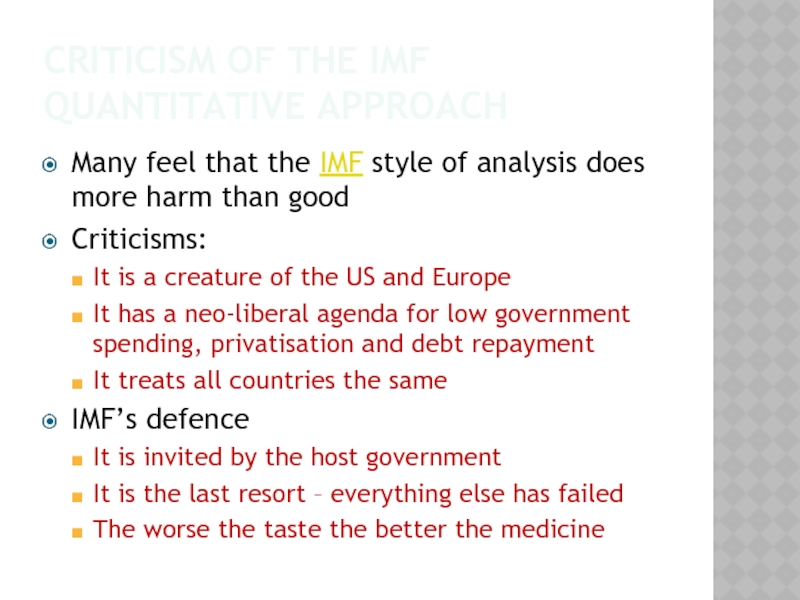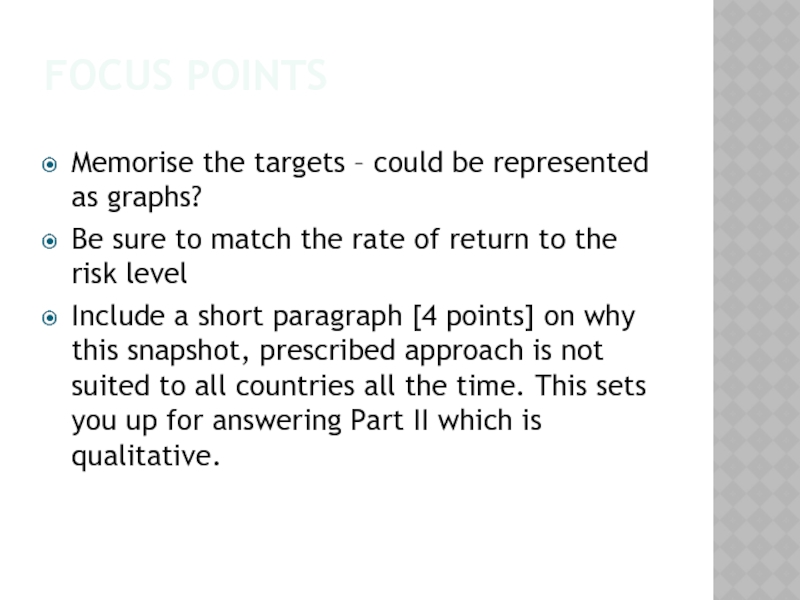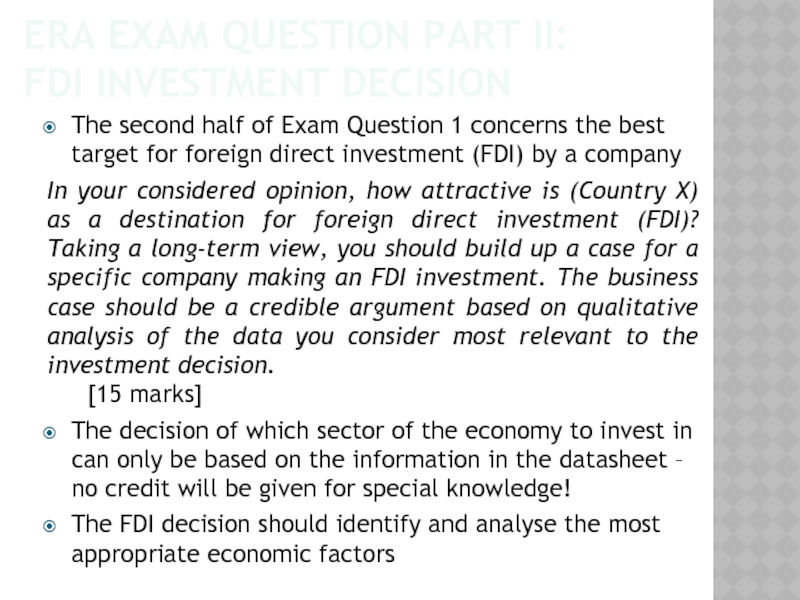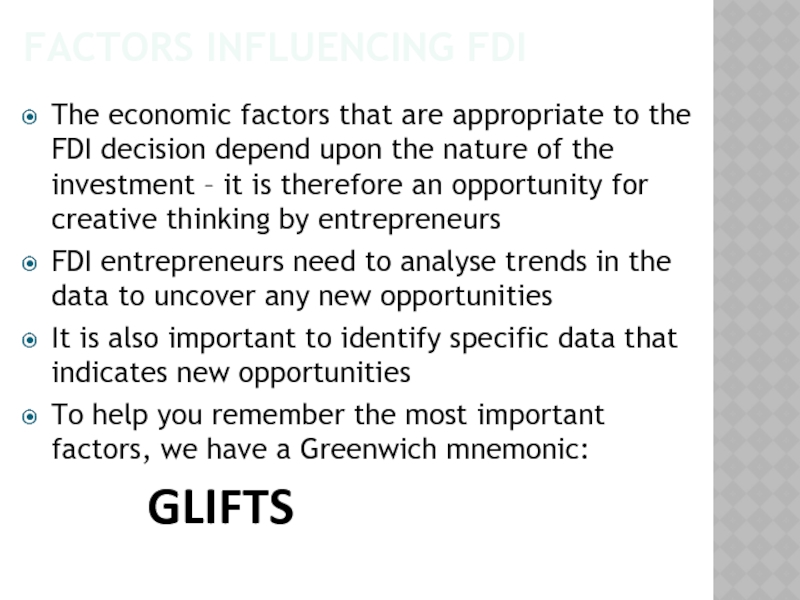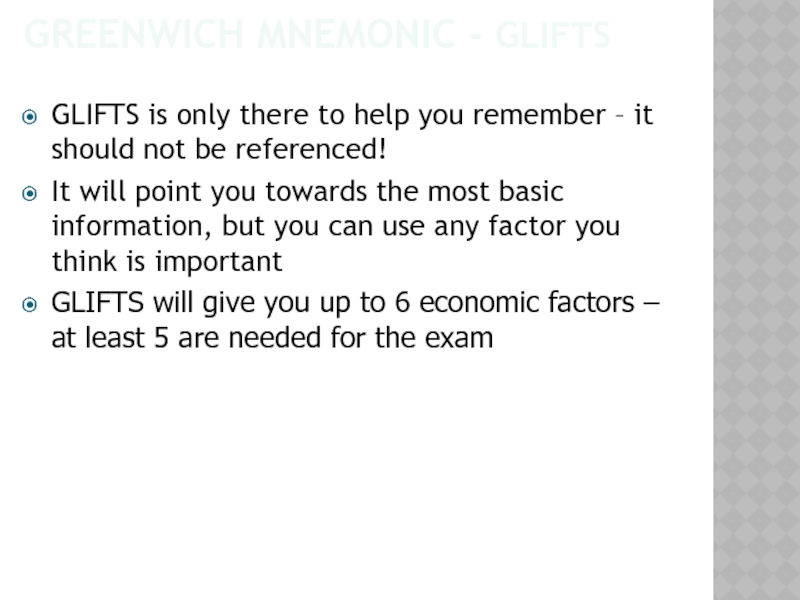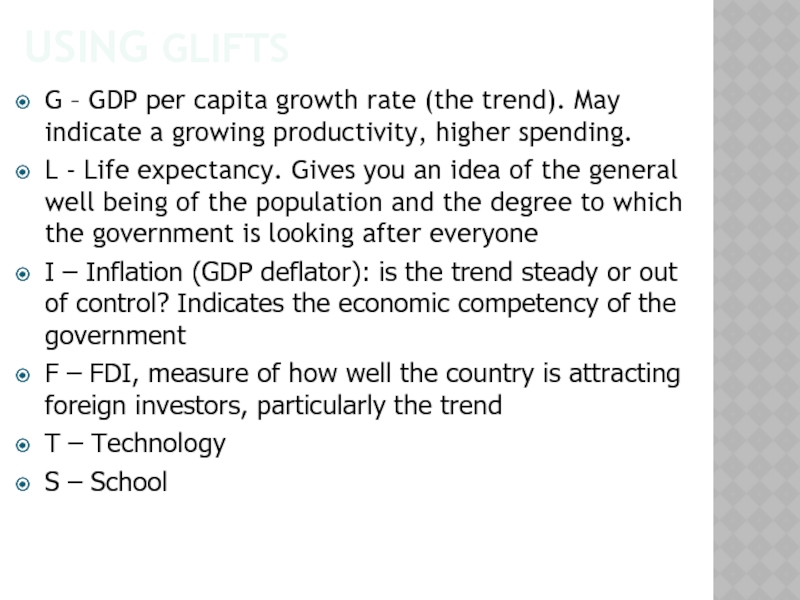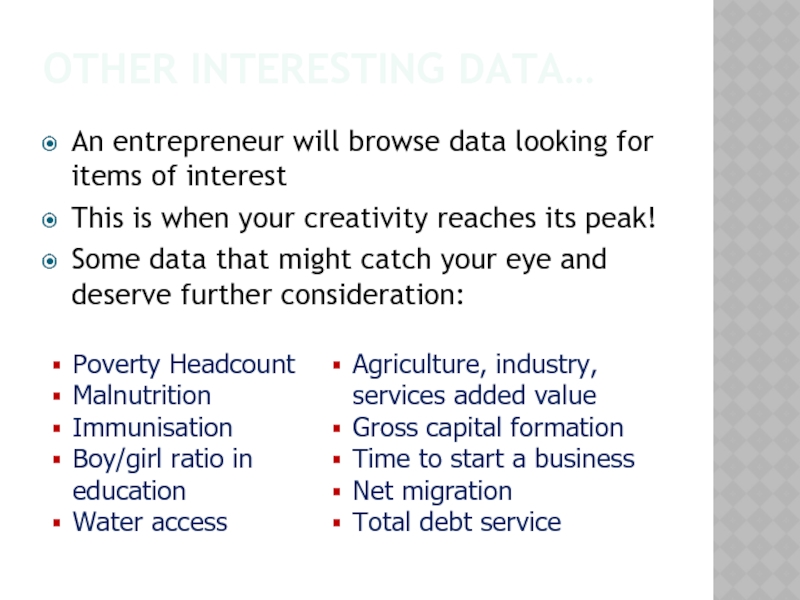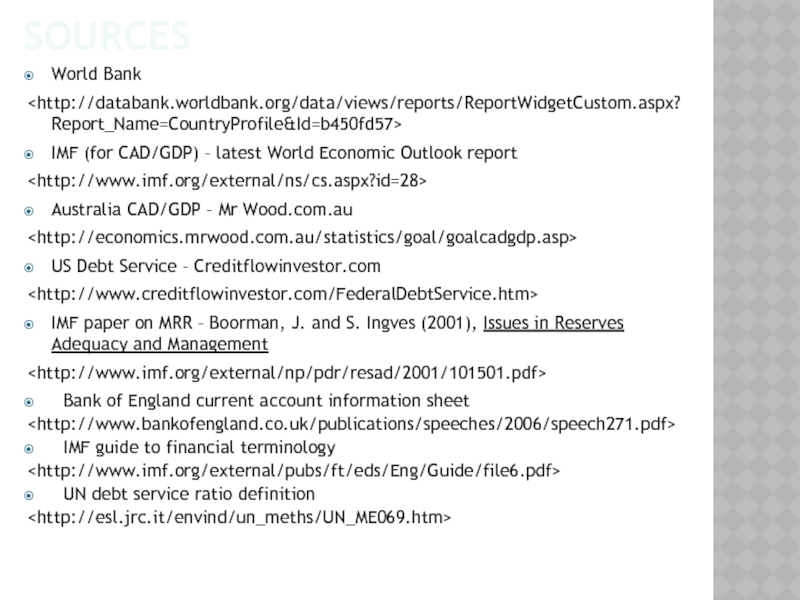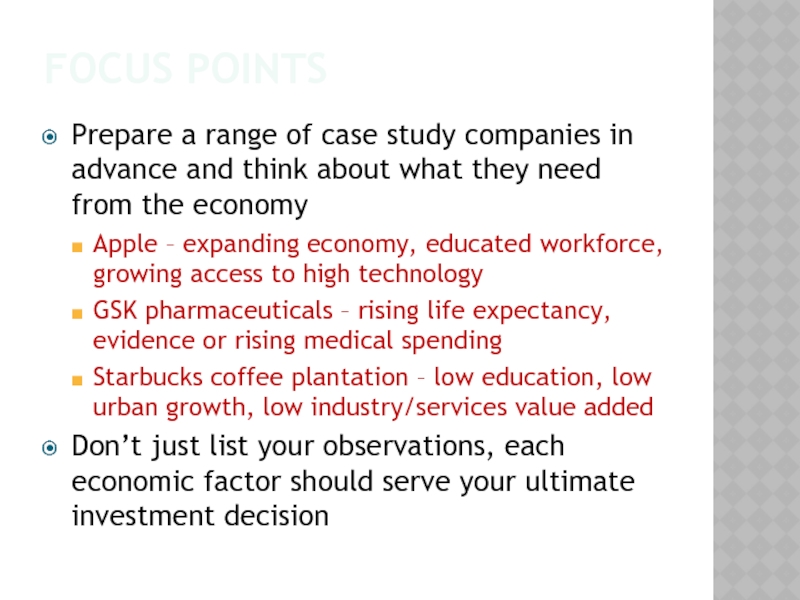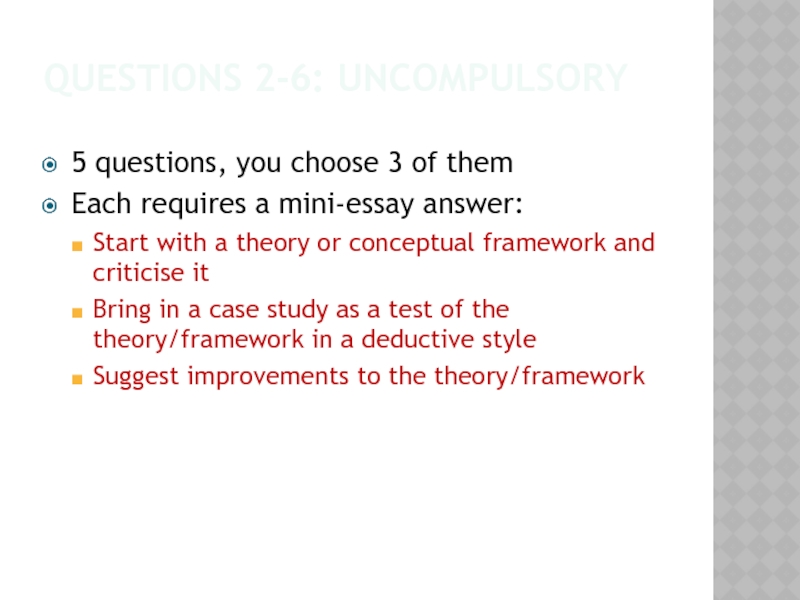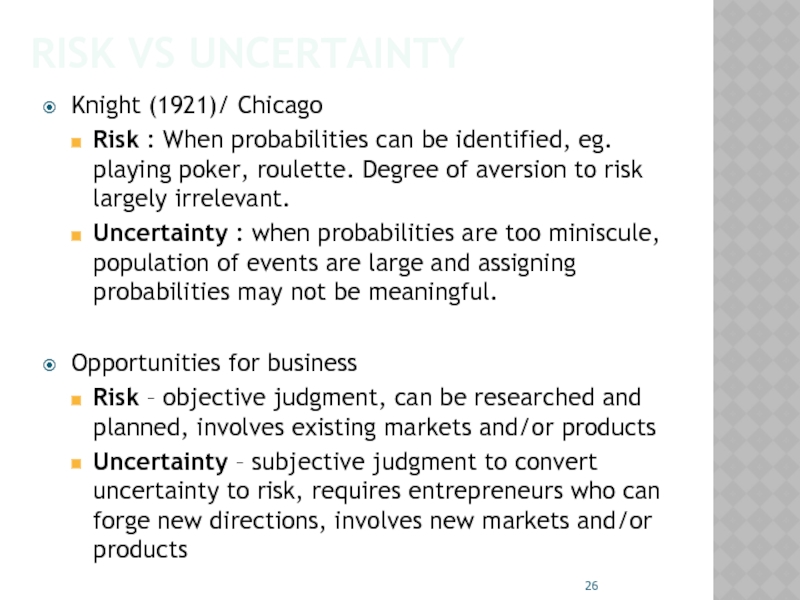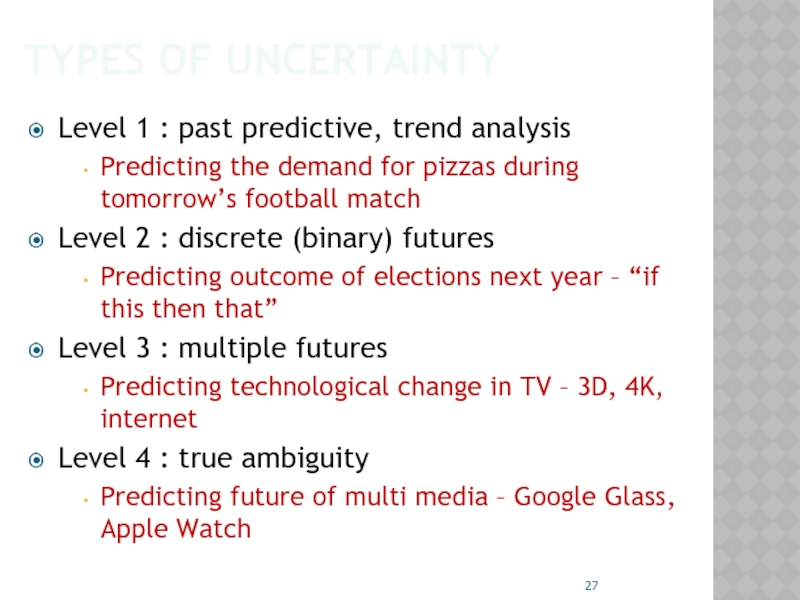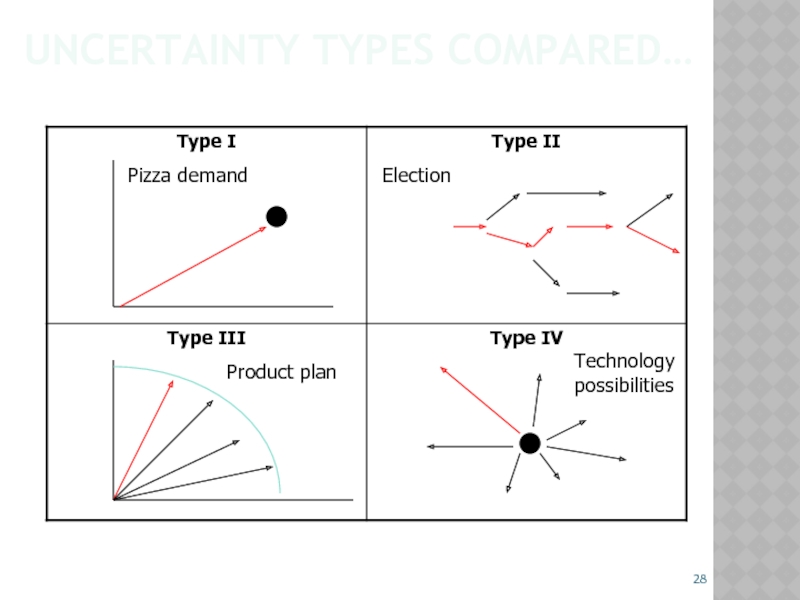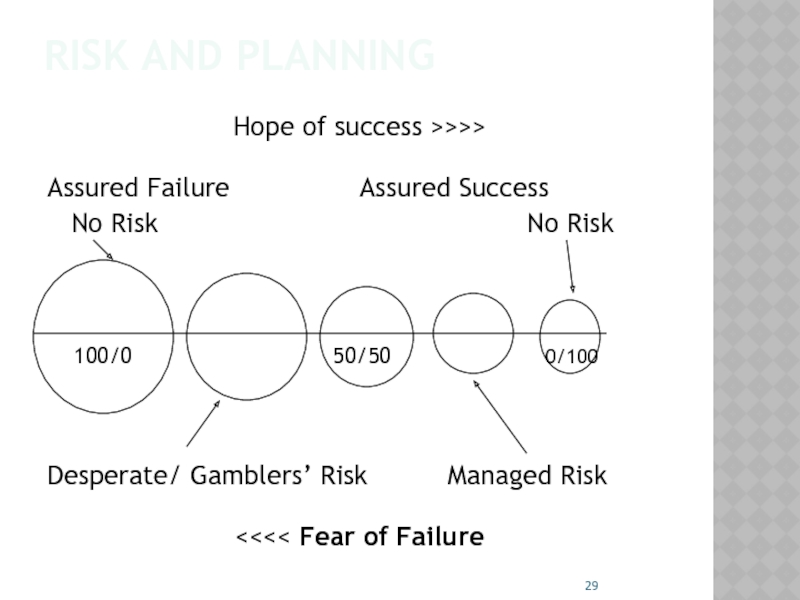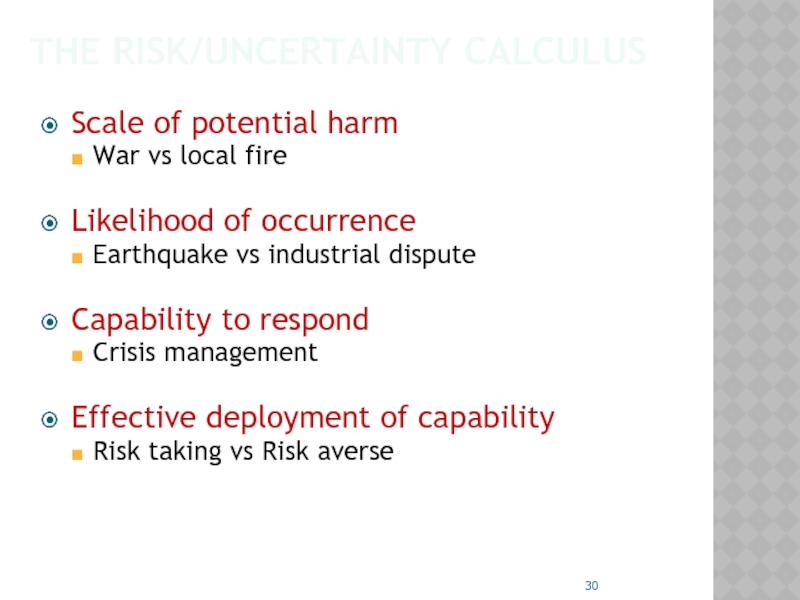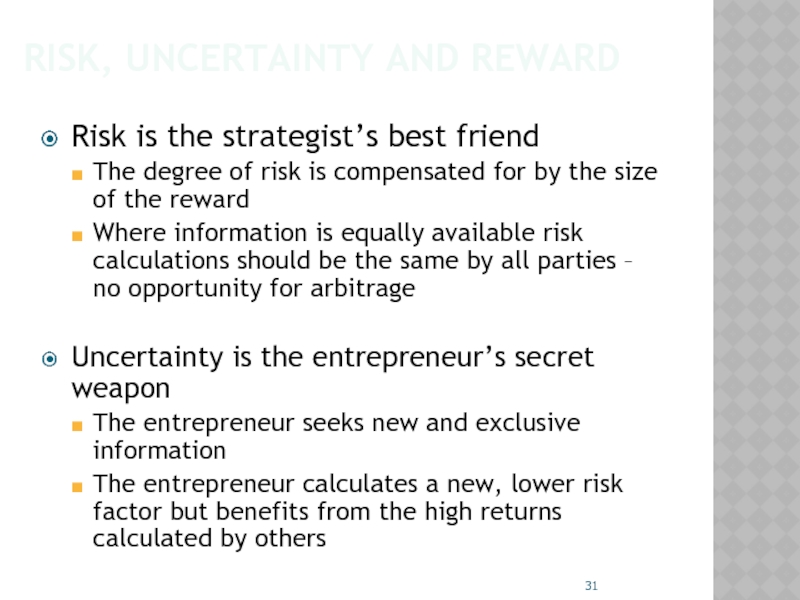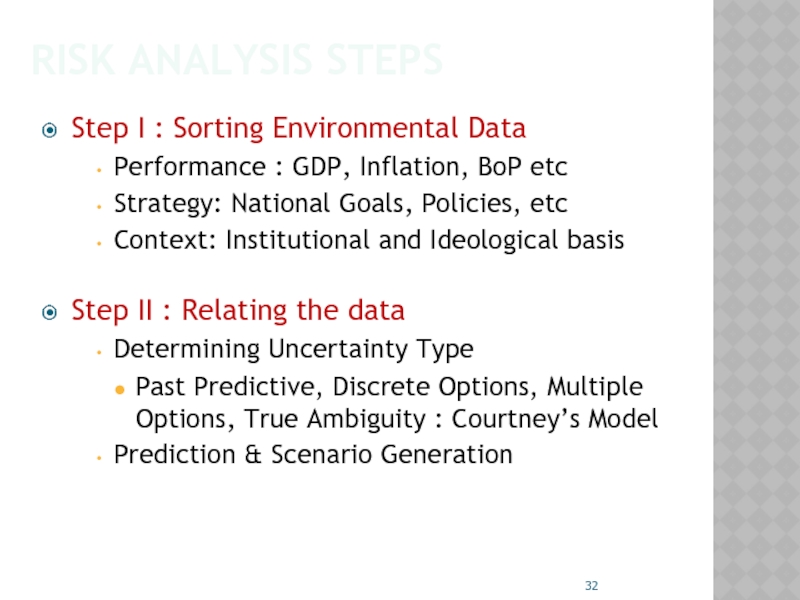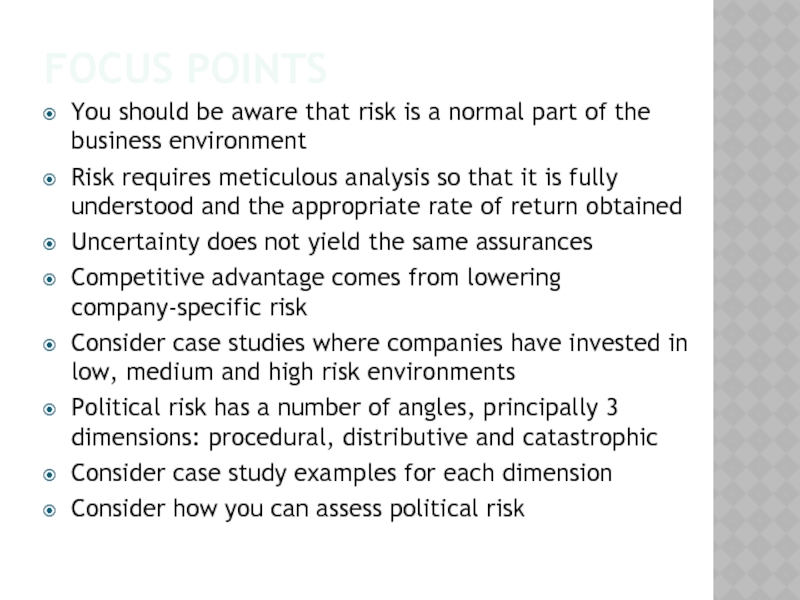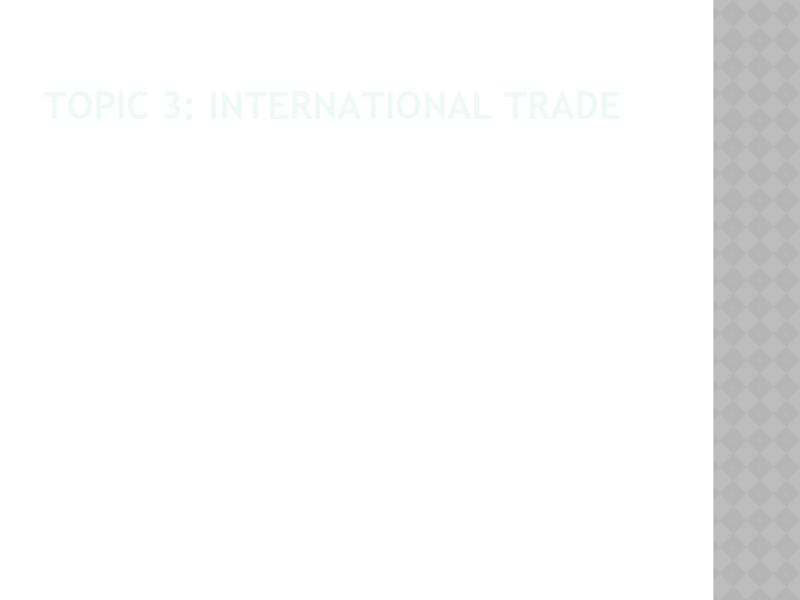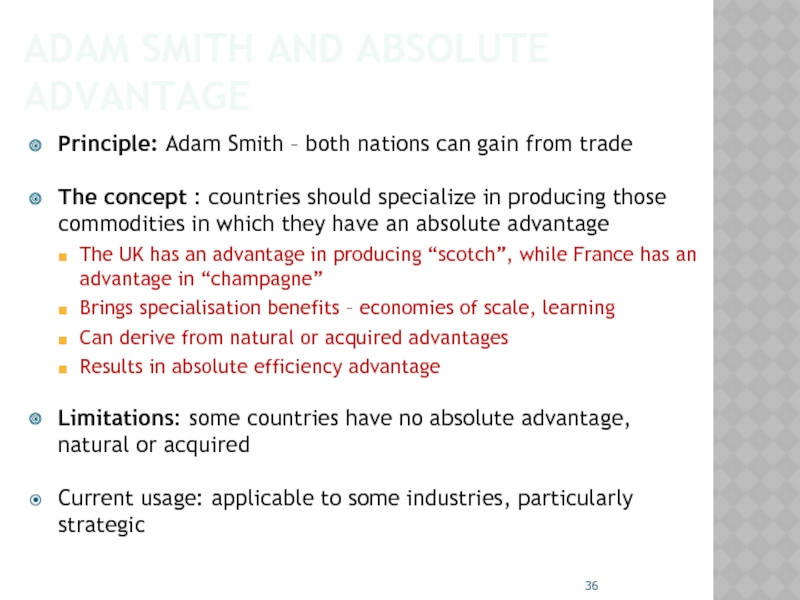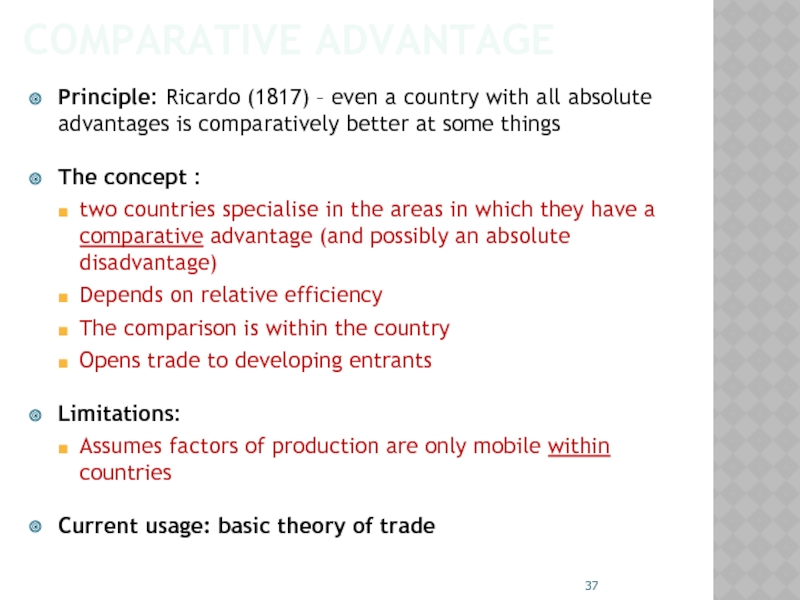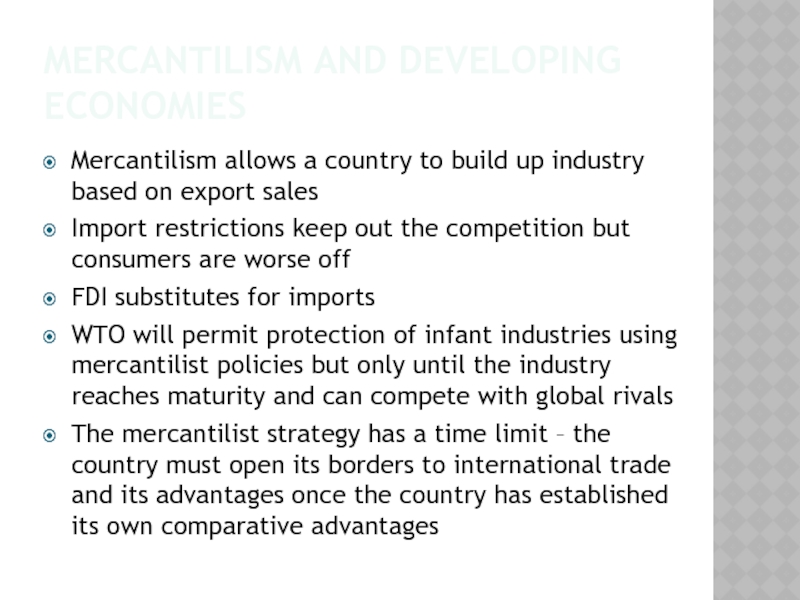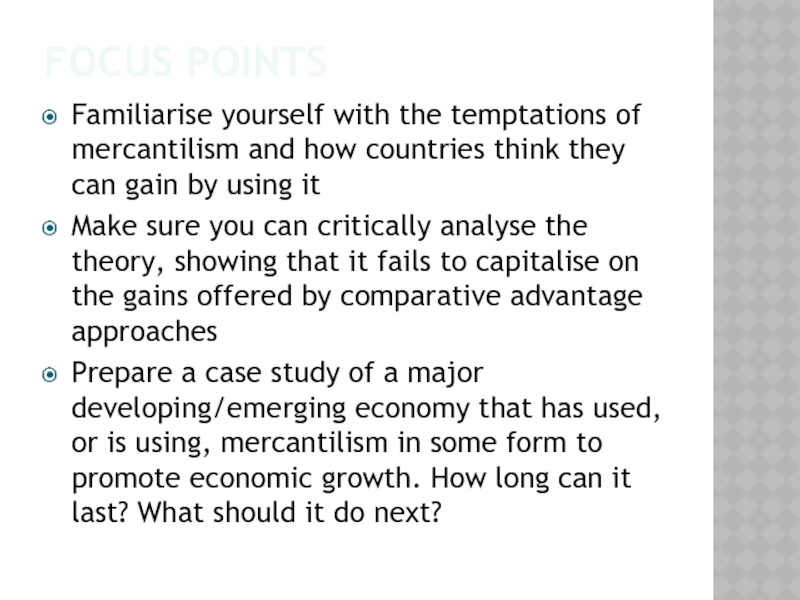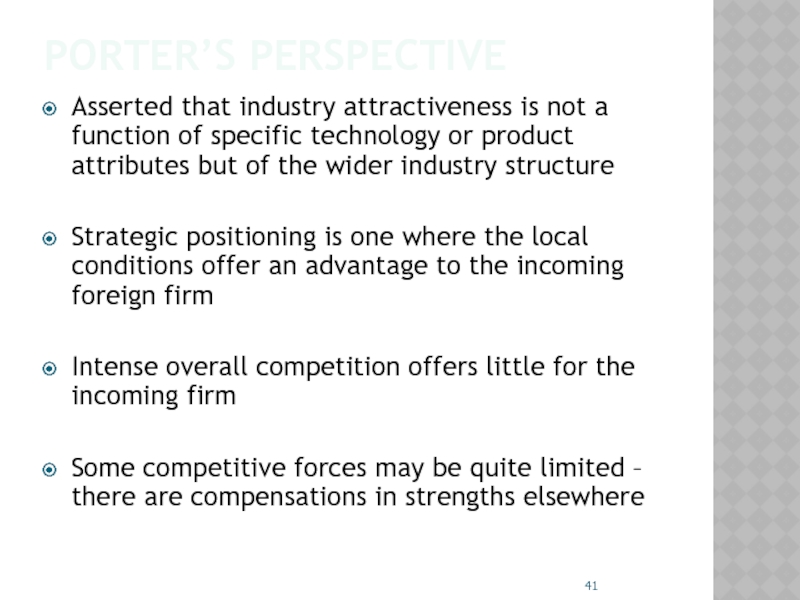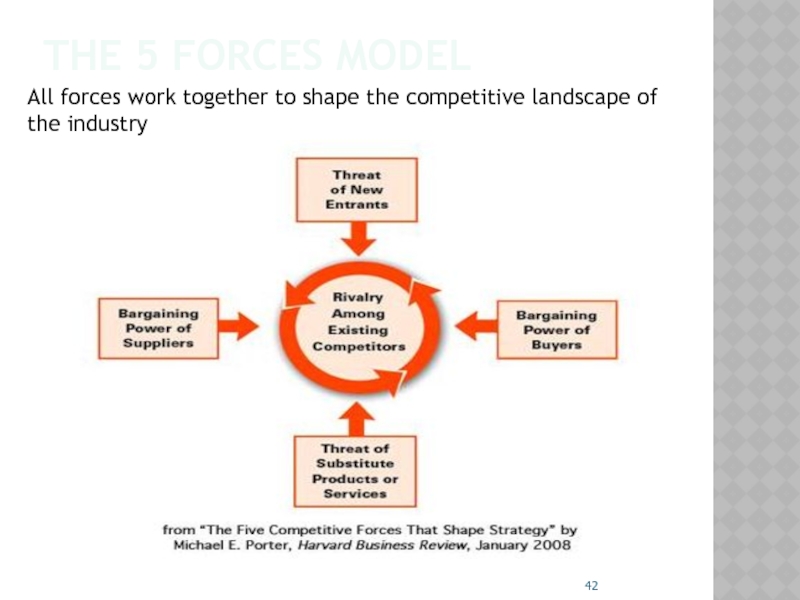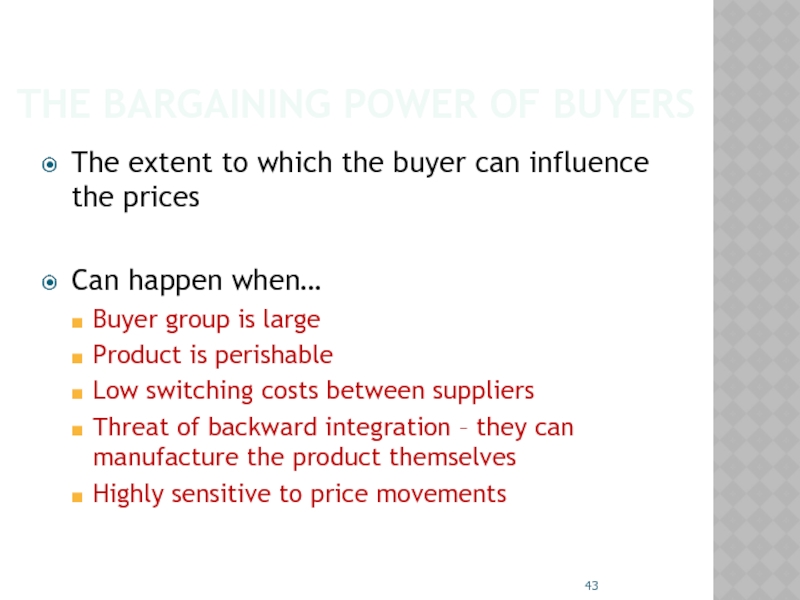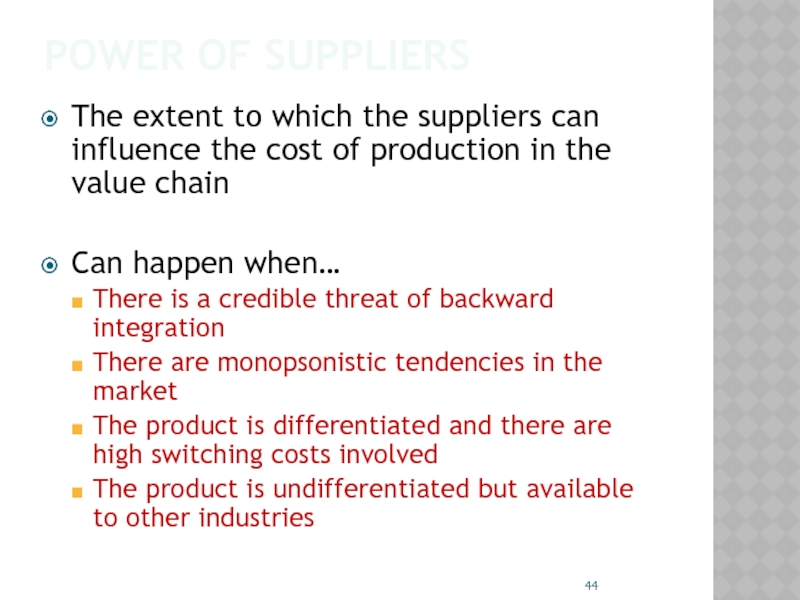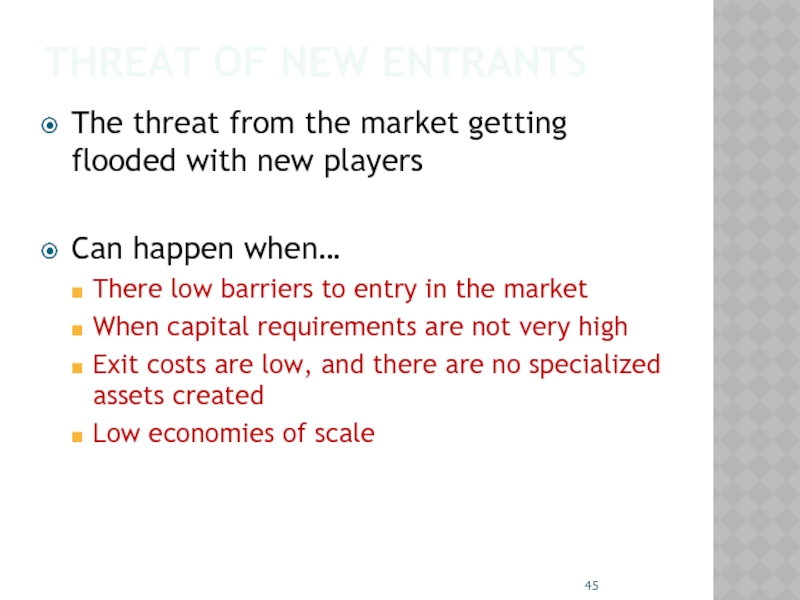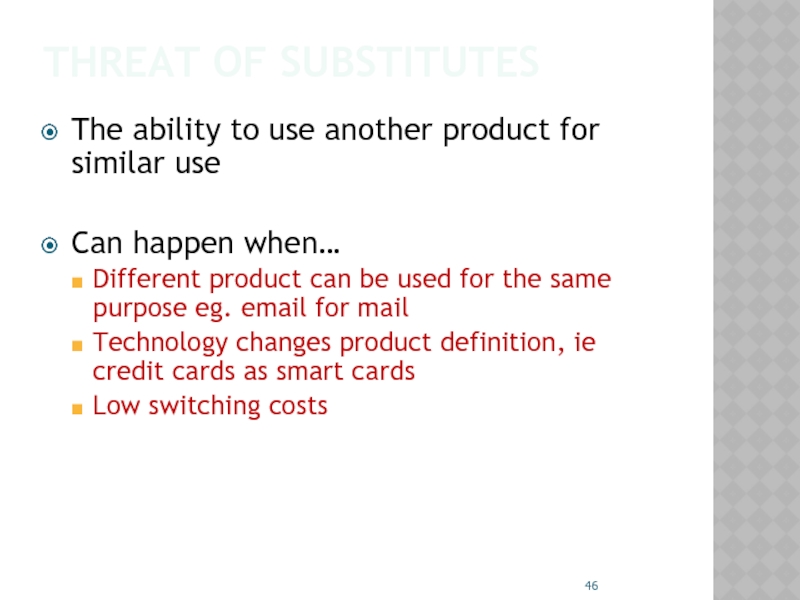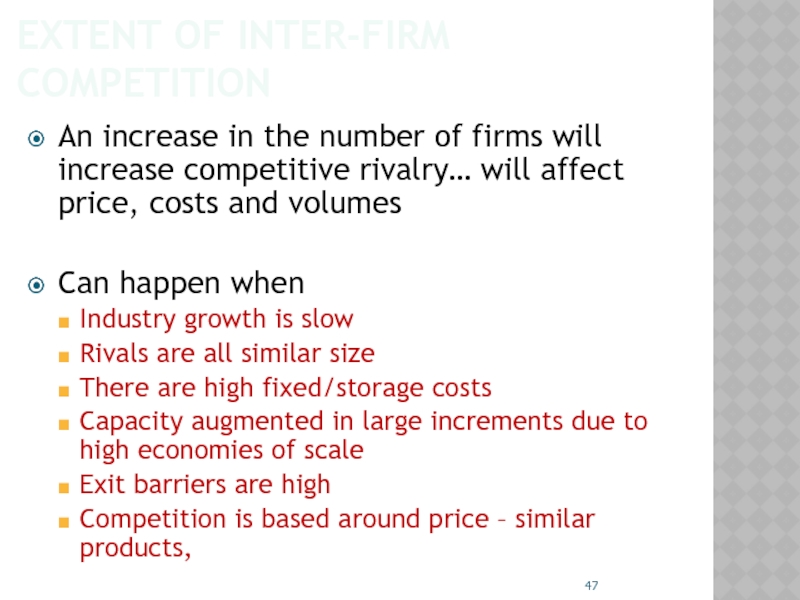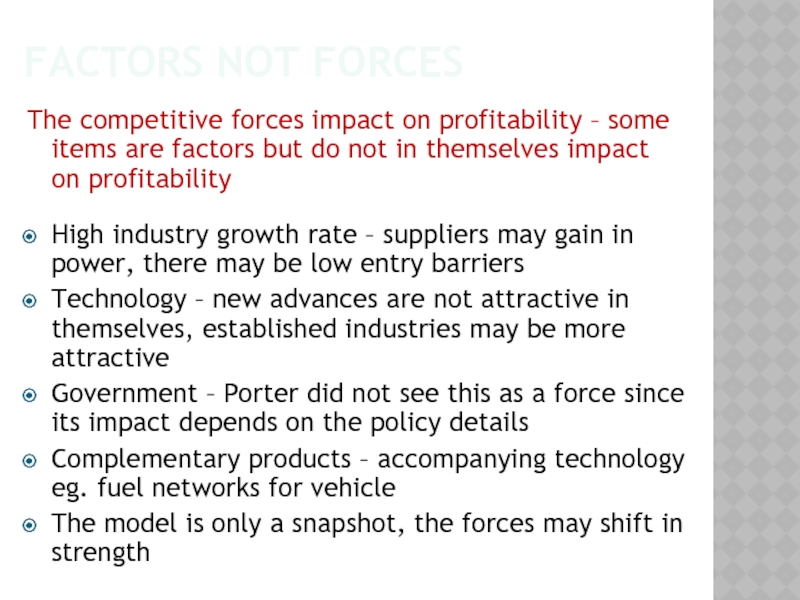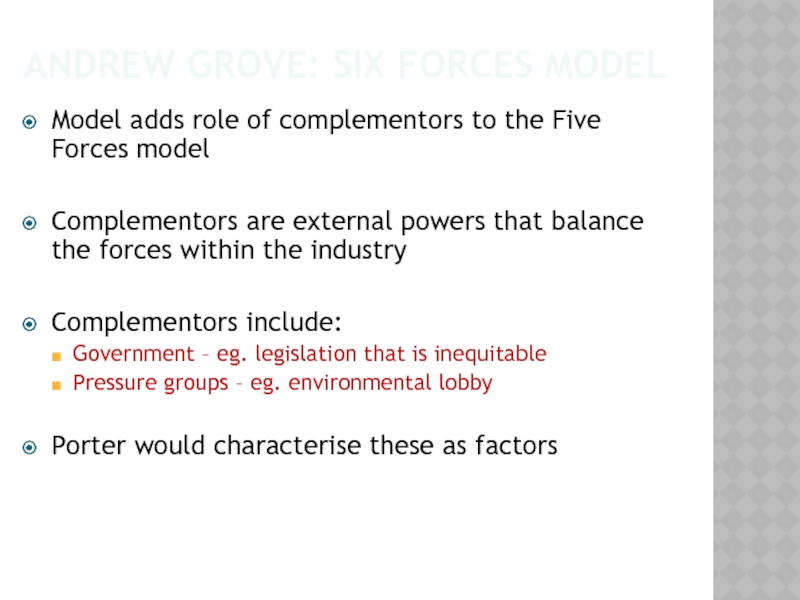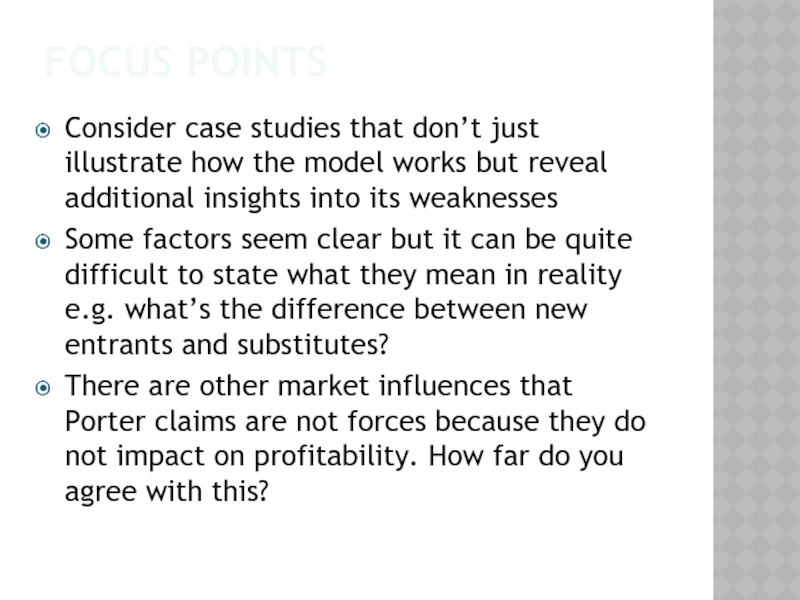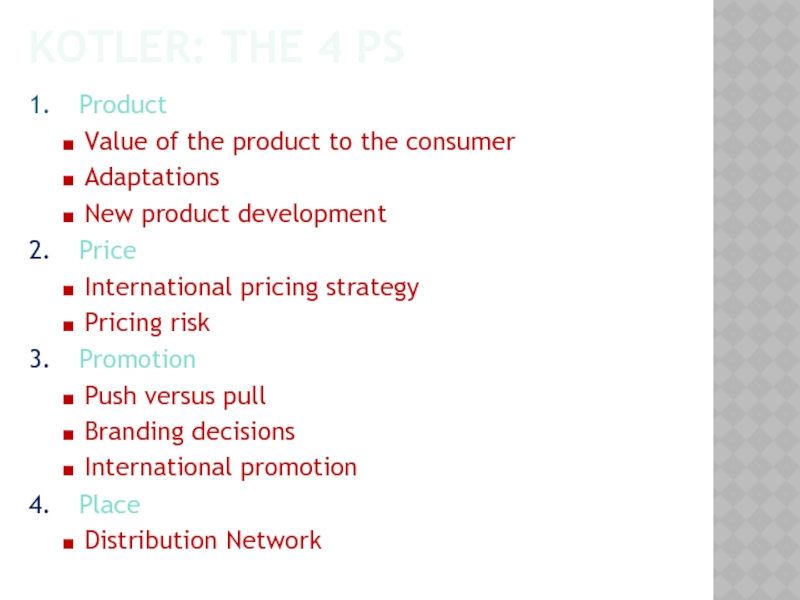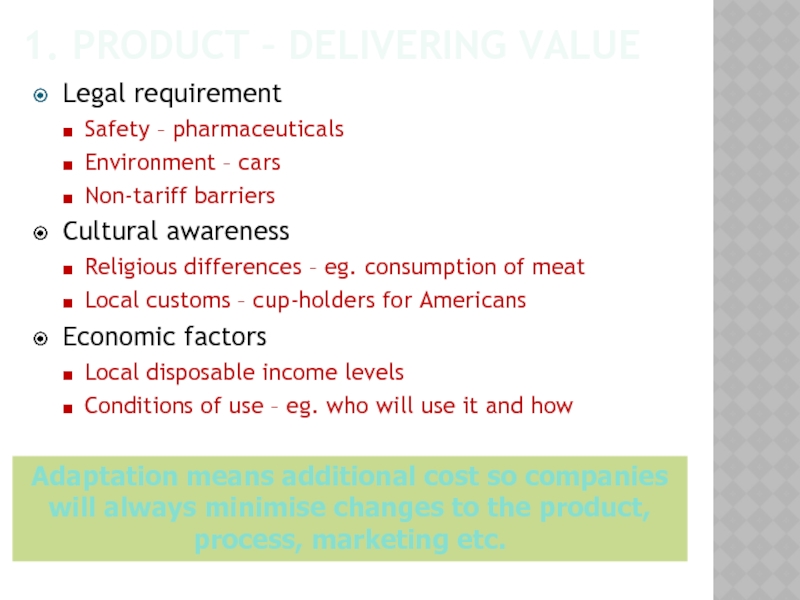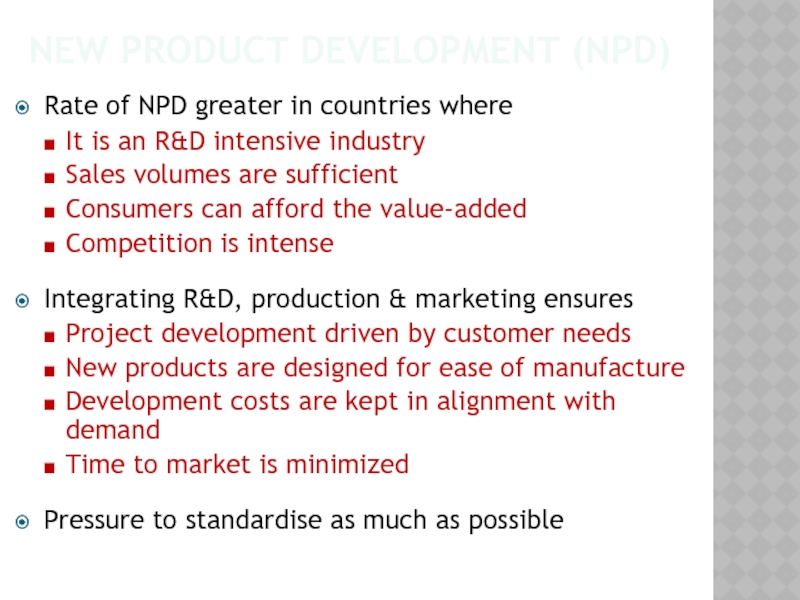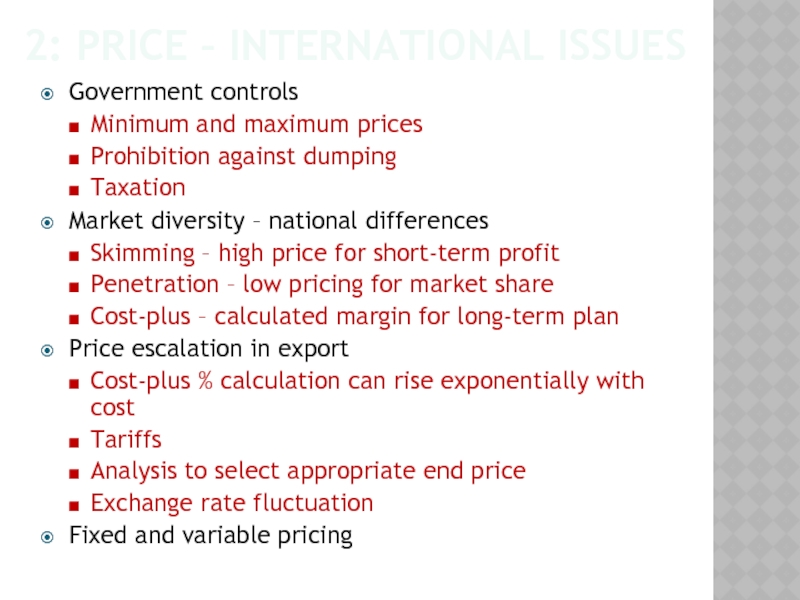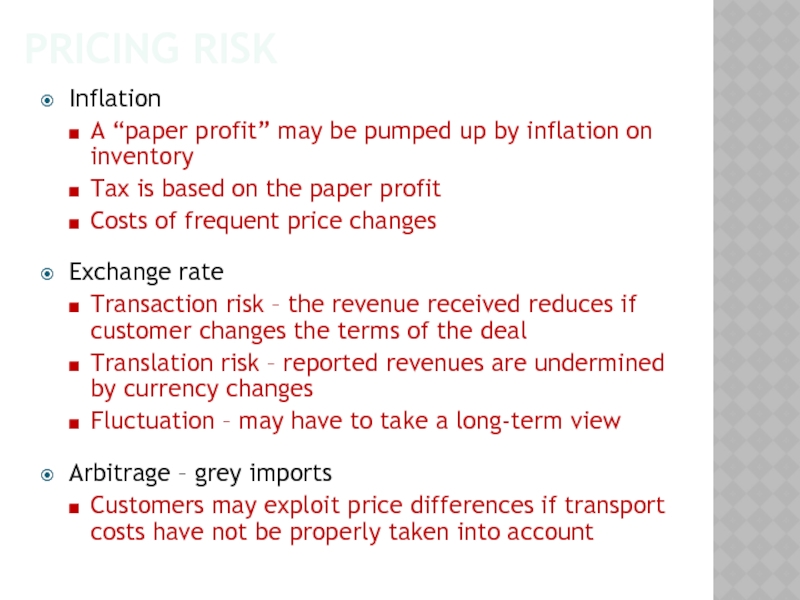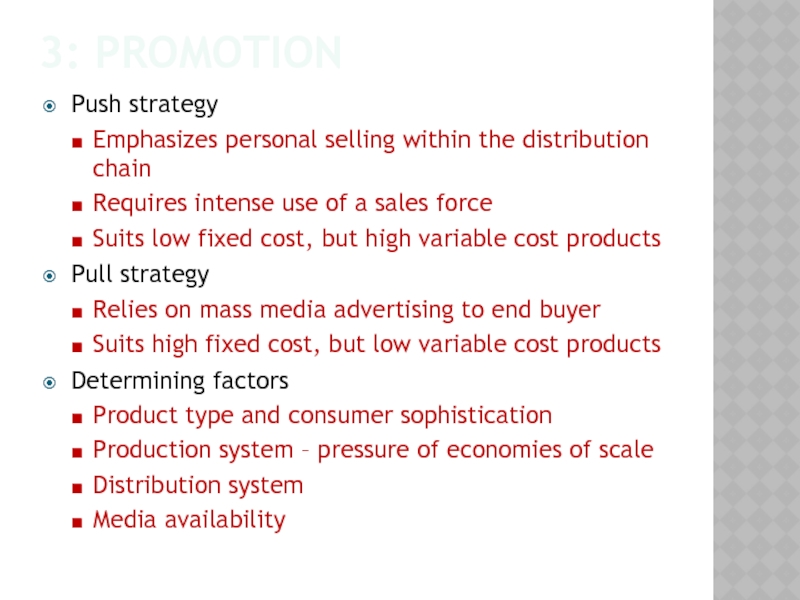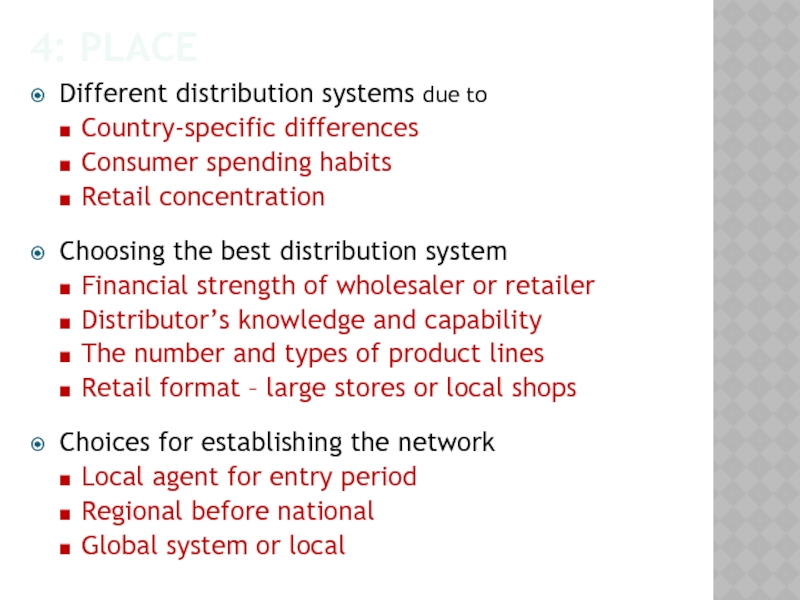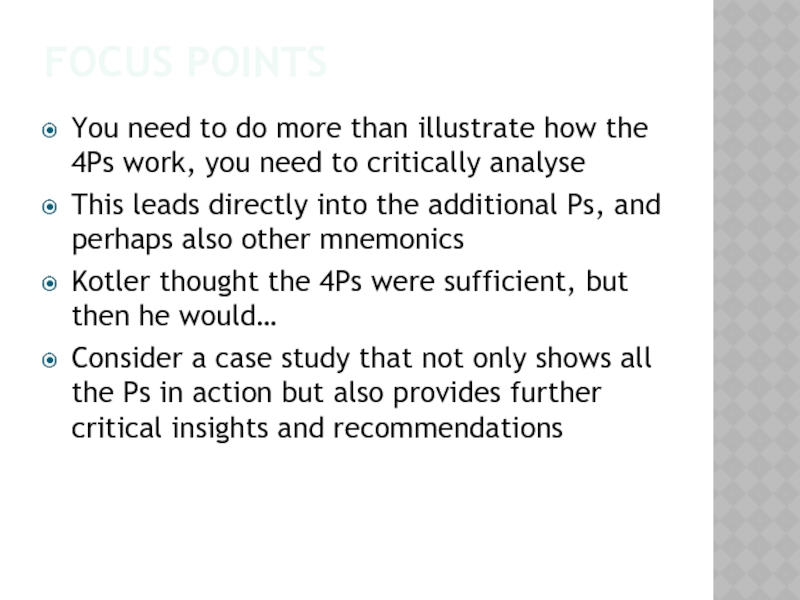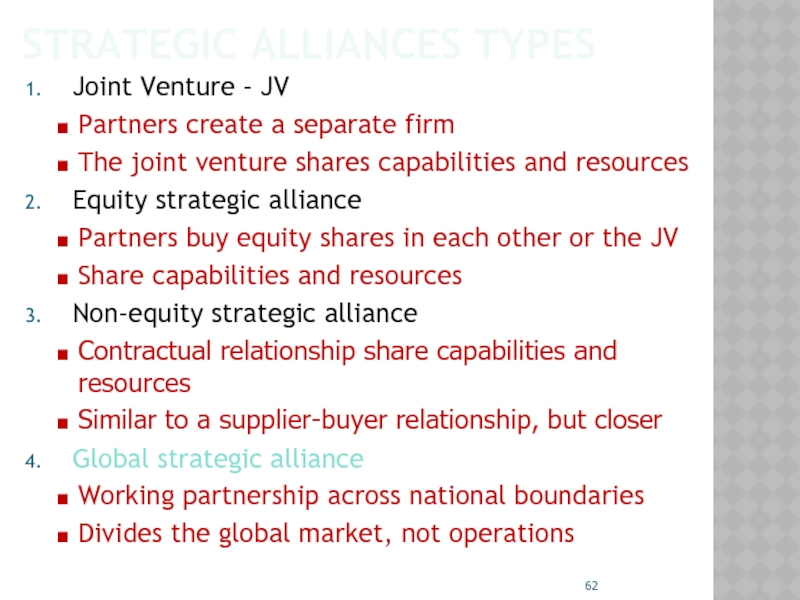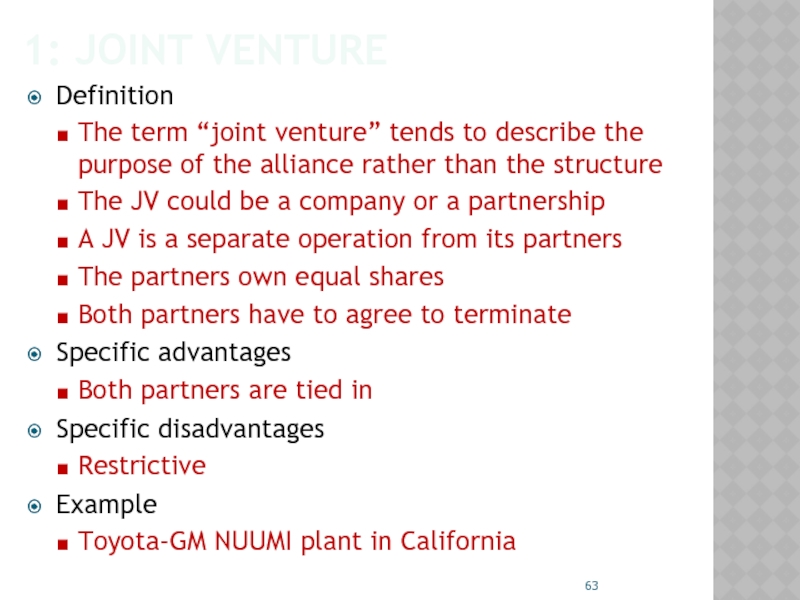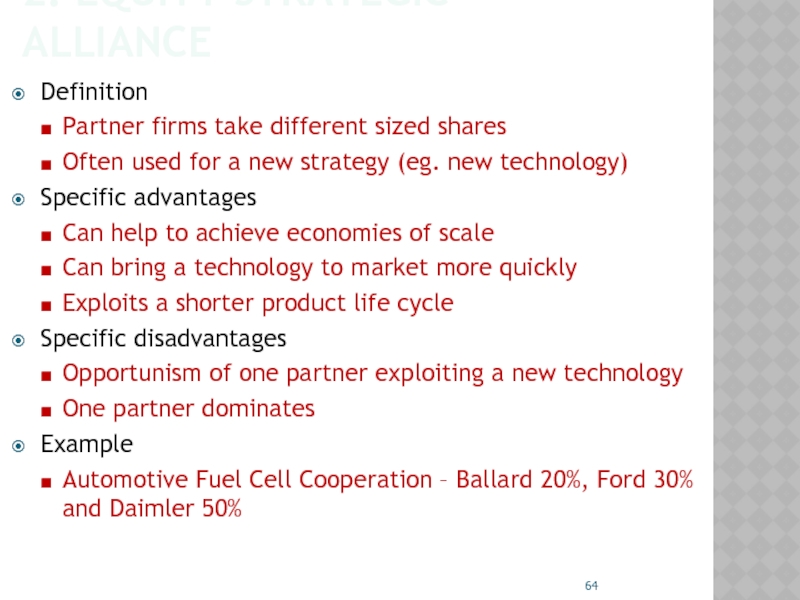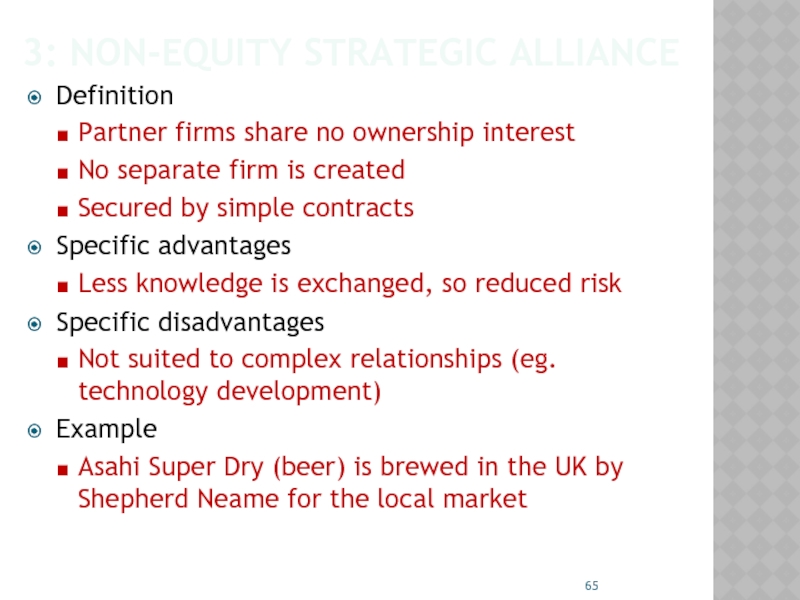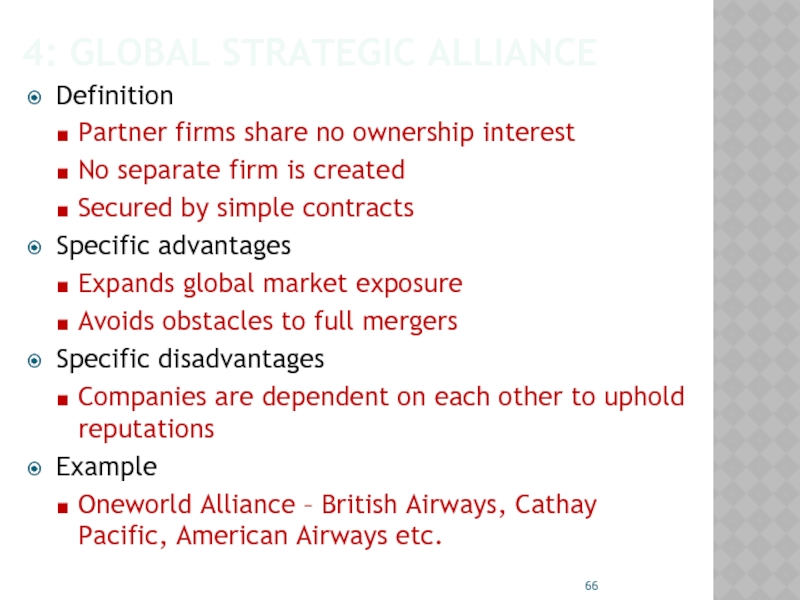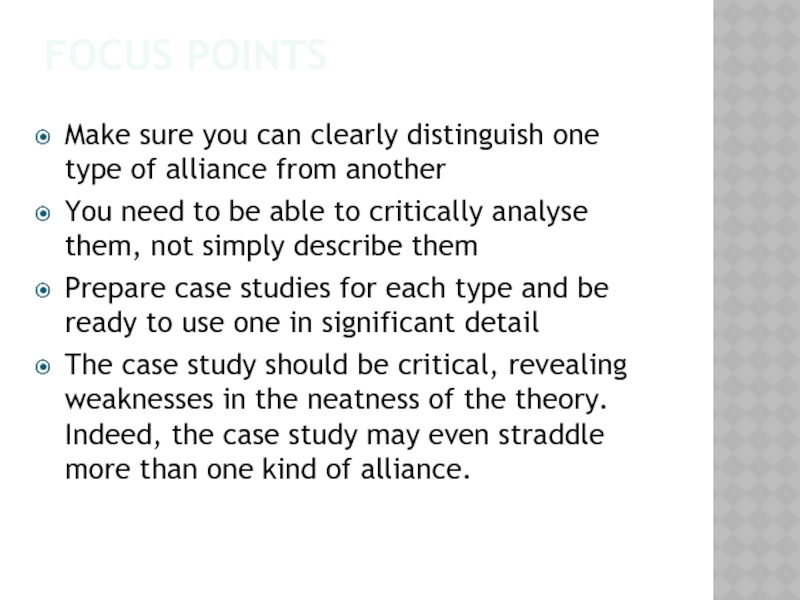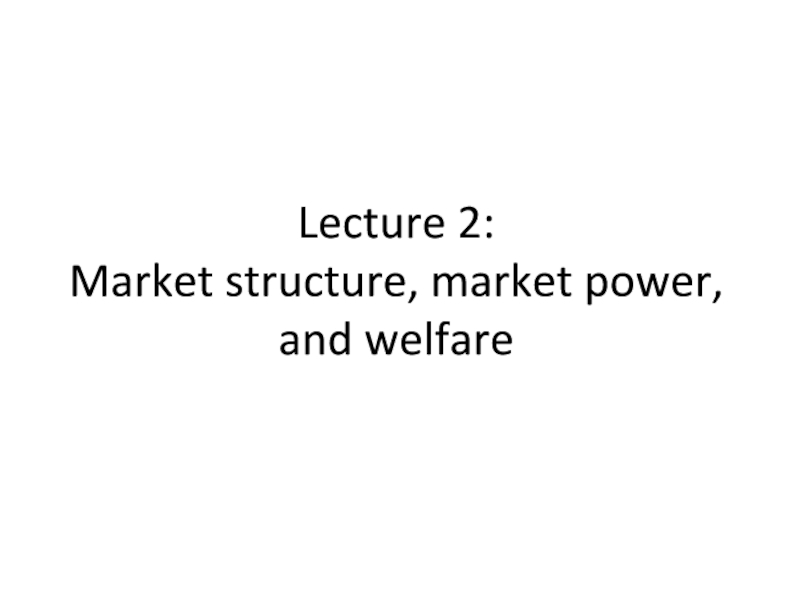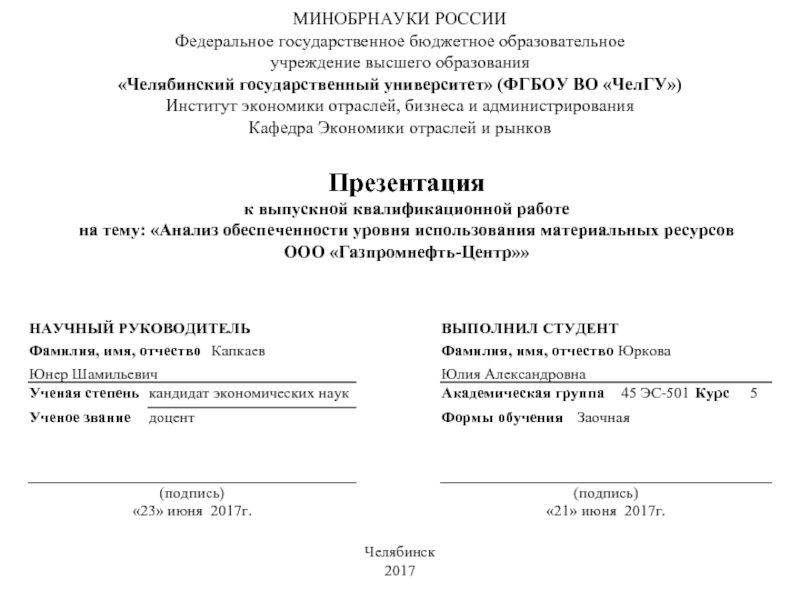- Главная
- Разное
- Дизайн
- Бизнес и предпринимательство
- Аналитика
- Образование
- Развлечения
- Красота и здоровье
- Финансы
- Государство
- Путешествия
- Спорт
- Недвижимость
- Армия
- Графика
- Культурология
- Еда и кулинария
- Лингвистика
- Английский язык
- Астрономия
- Алгебра
- Биология
- География
- Детские презентации
- Информатика
- История
- Литература
- Маркетинг
- Математика
- Медицина
- Менеджмент
- Музыка
- МХК
- Немецкий язык
- ОБЖ
- Обществознание
- Окружающий мир
- Педагогика
- Русский язык
- Технология
- Физика
- Философия
- Химия
- Шаблоны, картинки для презентаций
- Экология
- Экономика
- Юриспруденция
International business management. Course revision презентация
Содержание
- 1. International business management. Course revision
- 2. COURSE REVISION The following topics highlight the
- 3. QUESTION 1: COMPULSORY You must do Question
- 4. TOPIC 1: ECONOMIC RISK ANALYSIS FOR EMERGING ECONOMIES
- 5. ECONOMIC RISK ANALYSIS (ERA) IMF uses quantitative
- 6. FINDING THE DATA Most of the data
- 7. ERA EXAM QUESTION PART I: QUANTITATIVE DATA
- 8. 1. GDP GROWTH Question: is the economy
- 9. GDP GROWTH TARGETS Need to find a
- 10. GDP RISK AND RETURN FOR EMERGING ECONOMIES
- 11. 2: INFLATION Question: Are prices under control?
- 12. INFLATION AND RISK/RETURN Most central banks are
- 13. 3: CURRENT ACCOUNT DEFICIT – CAD Question:
- 14. CURRENT ACCOUNT DEFICIT – CAD For developing
- 15. CRITICISM OF THE IMF QUANTITATIVE APPROACH Many
- 16. FOCUS POINTS Memorise the targets – could
- 17. ERA EXAM QUESTION PART II: FDI
- 18. FACTORS INFLUENCING FDI The economic factors
- 19. GREENWICH MNEMONIC - GLIFTS GLIFTS is
- 20. USING GLIFTS G – GDP per capita
- 21. OTHER INTERESTING DATA… An entrepreneur will browse
- 22. SOURCES World Bank IMF (for CAD/GDP)
- 23. FOCUS POINTS Prepare a range of case
- 24. QUESTIONS 2-6: UNCOMPULSORY 5 questions, you choose
- 25. TOPIC 2: RISK & UNCERTAINTY
- 26. RISK VS UNCERTAINTY Knight (1921)/ Chicago Risk
- 27. TYPES OF UNCERTAINTY Level 1 : past
- 28. UNCERTAINTY TYPES COMPARED… Pizza demand Technology possibilities Product plan Election
- 29. RISK AND PLANNING Hope of success >>>>
- 30. THE RISK/UNCERTAINTY CALCULUS Scale of potential harm
- 31. RISK, UNCERTAINTY AND REWARD Risk is the
- 32. RISK ANALYSIS STEPS Step I : Sorting
- 33. FOCUS POINTS You should be aware that
- 34. TOPIC 3: INTERNATIONAL TRADE
- 35. MERCANTALISM Principal: wealth based on holdings
- 36. ADAM SMITH AND ABSOLUTE ADVANTAGE Principle: Adam
- 37. COMPARATIVE ADVANTAGE Principle: Ricardo (1817) – even
- 38. MERCANTILISM AND DEVELOPING ECONOMIES Mercantilism allows a
- 39. FOCUS POINTS Familiarise yourself with the temptations
- 40. TOPIC 4: FIVE FORCES MODEL
- 41. PORTER’S PERSPECTIVE Asserted that industry attractiveness is
- 42. THE 5 FORCES MODEL All forces work
- 43. THE BARGAINING POWER OF BUYERS The extent
- 44. POWER OF SUPPLIERS The extent to which
- 45. THREAT OF NEW ENTRANTS The threat from
- 46. THREAT OF SUBSTITUTES The ability to use
- 47. EXTENT OF INTER-FIRM COMPETITION An increase
- 48. FACTORS NOT FORCES The competitive forces impact
- 49. ANDREW GROVE: SIX FORCES MODEL Model adds
- 50. FOCUS POINTS Consider case studies that don’t
- 51. TOPIC 5: INTERNATIONAL MARKETING
- 52. KOTLER: THE 4 PS Product Value of
- 53. 1. PRODUCT – DELIVERING VALUE Legal requirement
- 54. NEW PRODUCT DEVELOPMENT (NPD) Rate of NPD
- 55. 2: PRICE – INTERNATIONAL ISSUES Government controls
- 56. PRICING RISK Inflation A “paper profit” may
- 57. 3: PROMOTION Push strategy Emphasizes personal
- 58. 4: PLACE Different distribution systems due to
- 59. 3 MORE PS Service industries have intangible
- 60. FOCUS POINTS You need to do more
- 61. TOPIC 6: STRATEGIC ALLIANCES
- 62. STRATEGIC ALLIANCES TYPES Joint Venture - JV
- 63. 1: JOINT VENTURE Definition The term “joint
- 64. 2: EQUITY STRATEGIC ALLIANCE Definition Partner firms
- 65. 3: NON-EQUITY STRATEGIC ALLIANCE Definition Partner firms
- 66. 4: GLOBAL STRATEGIC ALLIANCE Definition Partner firms
- 67. FOCUS POINTS Make sure you can clearly
Слайд 2COURSE REVISION
The following topics highlight the prime learning points for the
They are not intended to indicate the contents of the exam paper
Where the course revision topics have been extracted from a set of lecture slides you are recommended to familiarise yourself with the original set and do background reading
Do not neglect other topics covered during the year
Слайд 3QUESTION 1: COMPULSORY
You must do Question 1
For the remaining questions you
Spend no more than 45 minutes on each question – the early points are easier to get than the later ones.
Слайд 5ECONOMIC RISK ANALYSIS (ERA)
IMF uses quantitative analysis for evaluating economies
Economic risk
Guidelines devised at Greenwich evaluate the security of doing business in the country
Emerging and developing countries tend to trade in a narrow range of products and depend on cash flow
The three main measures of a country’s financial standing:
GDP – how much is it producing?
Inflation – how well controlled?
Current Account – are the imports affordable?
The first part of compulsory Exam Question 1 uses simple IMF-style quantitative formulas to measure economic performance against a standard
The second part of the question identifies and evaluates the main economic factors in order to make a qualitative investment decision in the country
Слайд 6FINDING THE DATA
Most of the data is available from the World
The data is for all countries, not just emerging or developing economy clients of The Bank
One piece of data, for the current account/GDP, comes from the IMF World Economic Outlook (WEO)
In the exam the data will comprise the World Bank figures + CAD/GDP
The data sheet will be a Word file
The exam will focus on an emerging economy
Слайд 7ERA EXAM QUESTION PART I: QUANTITATIVE DATA
“Examine the data set provided
[10 marks]
Слайд 81. GDP GROWTH
Question: is the economy growing at a sustainable rate?
Answer:
Gross domestic product (GDP) measures everything produced in the country regardless of nationality
Real (constant prices) GDP increases show genuine growth in the economy
Positive, steady growth is always good but the gains may be unevenly distributed
Undesirable GDP conditions:
High growth – rising wages, inflation, imports and interest rates
Low growth – poor exploitation of resources, poor competitiveness, low wealth creation
Recession – wealth destruction, hysteresis effects
Слайд 9GDP GROWTH TARGETS
Need to find a balance between a booming economy
An overheating economy with high inflation is usually treated with high interest rates
A recessionary economy with low inflation is usually treated with low interest rates
Stagflation (low growth, high inflation) is a challenging paradox!
Rate of return should match the risk
Слайд 10GDP RISK AND RETURN FOR EMERGING ECONOMIES
Emerging economies can sustain high
Слайд 112: INFLATION
Question: Are prices under control?
Answer: compare the inflation with the
Various measures of inflation (RPI, CPI). World Bank use GDP deflator accounting for the nominal change in GDP i.e. reveals real GDP change
The GDP deflator is inflation for all output, not a basket of goods
High inflation
High inflation means constant adjustment to prices
Usually necessitates high interest rates.
Debts values are eroded over time
Low inflation/Deflation
Low inflation is too narrow a target, can slip into deflation
Deflation may require negative interest rates – tricky!
Some consumers may wait for further price reductions
Debts values increase over time
Some positive rate of inflation is desired
Слайд 12INFLATION AND RISK/RETURN
Most central banks are targeting 2.0% CPI inflation
Some central
On balance, 0.0-2.0% inflation is probably considered low risk
World Bank data shows inflation as GDP deflator
Слайд 133: CURRENT ACCOUNT DEFICIT – CAD
Question: how great is the short-term
Answer: compare the current account deficit (CAD) and the gross domestic product (GDP)
CAD itself is not a worry:
It is funded from the capital account
It may be small compared to the total assets and liabilities
It may be a sign of strong domestic growth
The capital account could be showing good foreign investment
CAD/GDP percentage
It should be relatively stable over the years
It should be greater than -2% (i.e. -2.1% is high risk, -1.9% is low risk)
Слайд 14CURRENT ACCOUNT DEFICIT – CAD
For developing economies CAD can be a
Fall in investment means imports cannot be afforded
A fall in exports creates a higher dependency on foreign funds
A high surplus can also be cause for concern
Economic growth is dependent on demand in other countries
Domestic consumers have less access to desirable imports
The government needs to counter pressure on the currency to rise in value
Risk Values
Слайд 15CRITICISM OF THE IMF QUANTITATIVE APPROACH
Many feel that the IMF style
Criticisms:
It is a creature of the US and Europe
It has a neo-liberal agenda for low government spending, privatisation and debt repayment
It treats all countries the same
IMF’s defence
It is invited by the host government
It is the last resort – everything else has failed
The worse the taste the better the medicine
Слайд 16FOCUS POINTS
Memorise the targets – could be represented as graphs?
Be sure
Include a short paragraph [4 points] on why this snapshot, prescribed approach is not suited to all countries all the time. This sets you up for answering Part II which is qualitative.
Слайд 17ERA EXAM QUESTION PART II:
FDI INVESTMENT DECISION
The second half of
In your considered opinion, how attractive is (Country X) as a destination for foreign direct investment (FDI)? Taking a long-term view, you should build up a case for a specific company making an FDI investment. The business case should be a credible argument based on qualitative analysis of the data you consider most relevant to the investment decision. [15 marks]
The decision of which sector of the economy to invest in can only be based on the information in the datasheet – no credit will be given for special knowledge!
The FDI decision should identify and analyse the most appropriate economic factors
Слайд 18FACTORS INFLUENCING FDI
The economic factors that are appropriate to the FDI
FDI entrepreneurs need to analyse trends in the data to uncover any new opportunities
It is also important to identify specific data that indicates new opportunities
To help you remember the most important factors, we have a Greenwich mnemonic:
GLIFTS
Слайд 19GREENWICH MNEMONIC - GLIFTS
GLIFTS is only there to help you remember
It will point you towards the most basic information, but you can use any factor you think is important
GLIFTS will give you up to 6 economic factors – at least 5 are needed for the exam
Слайд 20USING GLIFTS
G – GDP per capita growth rate (the trend). May
L - Life expectancy. Gives you an idea of the general well being of the population and the degree to which the government is looking after everyone
I – Inflation (GDP deflator): is the trend steady or out of control? Indicates the economic competency of the government
F – FDI, measure of how well the country is attracting foreign investors, particularly the trend
T – Technology
S – School
Слайд 21OTHER INTERESTING DATA…
An entrepreneur will browse data looking for items of
This is when your creativity reaches its peak!
Some data that might catch your eye and deserve further consideration:
Poverty Headcount
Malnutrition
Immunisation
Boy/girl ratio in education
Water access
Agriculture, industry, services added value
Gross capital formation
Time to start a business
Net migration
Total debt service
Слайд 22SOURCES
World Bank
IMF (for CAD/GDP) – latest World Economic Outlook report
Australia CAD/GDP
US Debt Service – Creditflowinvestor.com
IMF paper on MRR – Boorman, J. and S. Ingves (2001), Issues in Reserves Adequacy and Management
Bank of England current account information sheet
IMF guide to financial terminology
UN debt service ratio definition
Слайд 23FOCUS POINTS
Prepare a range of case study companies in advance and
Apple – expanding economy, educated workforce, growing access to high technology
GSK pharmaceuticals – rising life expectancy, evidence or rising medical spending
Starbucks coffee plantation – low education, low urban growth, low industry/services value added
Don’t just list your observations, each economic factor should serve your ultimate investment decision
Слайд 24QUESTIONS 2-6: UNCOMPULSORY
5 questions, you choose 3 of them
Each requires a
Start with a theory or conceptual framework and criticise it
Bring in a case study as a test of the theory/framework in a deductive style
Suggest improvements to the theory/framework
Слайд 26RISK VS UNCERTAINTY
Knight (1921)/ Chicago
Risk : When probabilities can be identified,
Uncertainty : when probabilities are too miniscule, population of events are large and assigning probabilities may not be meaningful.
Opportunities for business
Risk – objective judgment, can be researched and planned, involves existing markets and/or products
Uncertainty – subjective judgment to convert uncertainty to risk, requires entrepreneurs who can forge new directions, involves new markets and/or products
Слайд 27TYPES OF UNCERTAINTY
Level 1 : past predictive, trend analysis
Predicting the demand
Level 2 : discrete (binary) futures
Predicting outcome of elections next year – “if this then that”
Level 3 : multiple futures
Predicting technological change in TV – 3D, 4K, internet
Level 4 : true ambiguity
Predicting future of multi media – Google Glass, Apple Watch
Слайд 29RISK AND PLANNING
Hope of success >>>>
Assured Failure Assured Success
100/0 50/50 0/100
Desperate/ Gamblers’ Risk Managed Risk
<<<< Fear of Failure
Слайд 30THE RISK/UNCERTAINTY CALCULUS
Scale of potential harm
War vs local fire
Likelihood of occurrence
Earthquake
Capability to respond
Crisis management
Effective deployment of capability
Risk taking vs Risk averse
Слайд 31RISK, UNCERTAINTY AND REWARD
Risk is the strategist’s best friend
The degree of
Where information is equally available risk calculations should be the same by all parties – no opportunity for arbitrage
Uncertainty is the entrepreneur’s secret weapon
The entrepreneur seeks new and exclusive information
The entrepreneur calculates a new, lower risk factor but benefits from the high returns calculated by others
Слайд 32RISK ANALYSIS STEPS
Step I : Sorting Environmental Data
Performance : GDP, Inflation,
Strategy: National Goals, Policies, etc
Context: Institutional and Ideological basis
Step II : Relating the data
Determining Uncertainty Type
Past Predictive, Discrete Options, Multiple Options, True Ambiguity : Courtney’s Model
Prediction & Scenario Generation
Слайд 33FOCUS POINTS
You should be aware that risk is a normal part
Risk requires meticulous analysis so that it is fully understood and the appropriate rate of return obtained
Uncertainty does not yield the same assurances
Competitive advantage comes from lowering company-specific risk
Consider case studies where companies have invested in low, medium and high risk environments
Political risk has a number of angles, principally 3 dimensions: procedural, distributive and catastrophic
Consider case study examples for each dimension
Consider how you can assess political risk
Слайд 35MERCANTALISM
Principal: wealth based on holdings of gold
The Concept: Trade is
Drove the economic expansion in the 17th /18th centuries
Imperialism was also in line with military power
Colonies forced to export commodities and import manufactured products
The Limitations:
De-industrialisation, brain drain, adverse movement of factors of production from colonies
Inefficient production
Rising inflation
Current usage: neo-mercantilism is politically attractive
Слайд 36ADAM SMITH AND ABSOLUTE ADVANTAGE
Principle: Adam Smith – both nations can
The concept : countries should specialize in producing those commodities in which they have an absolute advantage
The UK has an advantage in producing “scotch”, while France has an advantage in “champagne”
Brings specialisation benefits – economies of scale, learning
Can derive from natural or acquired advantages
Results in absolute efficiency advantage
Limitations: some countries have no absolute advantage, natural or acquired
Current usage: applicable to some industries, particularly strategic
Слайд 37COMPARATIVE ADVANTAGE
Principle: Ricardo (1817) – even a country with all absolute
The concept :
two countries specialise in the areas in which they have a comparative advantage (and possibly an absolute disadvantage)
Depends on relative efficiency
The comparison is within the country
Opens trade to developing entrants
Limitations:
Assumes factors of production are only mobile within countries
Current usage: basic theory of trade
Слайд 38MERCANTILISM AND DEVELOPING ECONOMIES
Mercantilism allows a country to build up industry
Import restrictions keep out the competition but consumers are worse off
FDI substitutes for imports
WTO will permit protection of infant industries using mercantilist policies but only until the industry reaches maturity and can compete with global rivals
The mercantilist strategy has a time limit – the country must open its borders to international trade and its advantages once the country has established its own comparative advantages
Слайд 39FOCUS POINTS
Familiarise yourself with the temptations of mercantilism and how countries
Make sure you can critically analyse the theory, showing that it fails to capitalise on the gains offered by comparative advantage approaches
Prepare a case study of a major developing/emerging economy that has used, or is using, mercantilism in some form to promote economic growth. How long can it last? What should it do next?
Слайд 41PORTER’S PERSPECTIVE
Asserted that industry attractiveness is not a function of specific
Strategic positioning is one where the local conditions offer an advantage to the incoming foreign firm
Intense overall competition offers little for the incoming firm
Some competitive forces may be quite limited – there are compensations in strengths elsewhere
Слайд 42THE 5 FORCES MODEL
All forces work together to shape the competitive
Слайд 43THE BARGAINING POWER OF BUYERS
The extent to which the buyer can
Can happen when…
Buyer group is large
Product is perishable
Low switching costs between suppliers
Threat of backward integration – they can manufacture the product themselves
Highly sensitive to price movements
Слайд 44POWER OF SUPPLIERS
The extent to which the suppliers can influence the
Can happen when…
There is a credible threat of backward integration
There are monopsonistic tendencies in the market
The product is differentiated and there are high switching costs involved
The product is undifferentiated but available to other industries
Слайд 45THREAT OF NEW ENTRANTS
The threat from the market getting flooded with
Can happen when…
There low barriers to entry in the market
When capital requirements are not very high
Exit costs are low, and there are no specialized assets created
Low economies of scale
Слайд 46THREAT OF SUBSTITUTES
The ability to use another product for similar use
Can
Different product can be used for the same purpose eg. email for mail
Technology changes product definition, ie credit cards as smart cards
Low switching costs
Слайд 47EXTENT OF INTER-FIRM COMPETITION
An increase in the number of firms
Can happen when
Industry growth is slow
Rivals are all similar size
There are high fixed/storage costs
Capacity augmented in large increments due to high economies of scale
Exit barriers are high
Competition is based around price – similar products,
Слайд 48FACTORS NOT FORCES
The competitive forces impact on profitability – some items
High industry growth rate – suppliers may gain in power, there may be low entry barriers
Technology – new advances are not attractive in themselves, established industries may be more attractive
Government – Porter did not see this as a force since its impact depends on the policy details
Complementary products – accompanying technology eg. fuel networks for vehicle
The model is only a snapshot, the forces may shift in strength
Слайд 49ANDREW GROVE: SIX FORCES MODEL
Model adds role of complementors to the
Complementors are external powers that balance the forces within the industry
Complementors include:
Government – eg. legislation that is inequitable
Pressure groups – eg. environmental lobby
Porter would characterise these as factors
Слайд 50FOCUS POINTS
Consider case studies that don’t just illustrate how the model
Some factors seem clear but it can be quite difficult to state what they mean in reality e.g. what’s the difference between new entrants and substitutes?
There are other market influences that Porter claims are not forces because they do not impact on profitability. How far do you agree with this?
Слайд 52KOTLER: THE 4 PS
Product
Value of the product to the consumer
Adaptations
New product
Price
International pricing strategy
Pricing risk
Promotion
Push versus pull
Branding decisions
International promotion
Place
Distribution Network
Слайд 531. PRODUCT – DELIVERING VALUE
Legal requirement
Safety – pharmaceuticals
Environment – cars
Non-tariff barriers
Cultural
Religious differences – eg. consumption of meat
Local customs – cup-holders for Americans
Economic factors
Local disposable income levels
Conditions of use – eg. who will use it and how
Adaptation means additional cost so companies will always minimise changes to the product, process, marketing etc.
Слайд 54NEW PRODUCT DEVELOPMENT (NPD)
Rate of NPD greater in countries where
It is
Sales volumes are sufficient
Consumers can afford the value-added
Competition is intense
Integrating R&D, production & marketing ensures
Project development driven by customer needs
New products are designed for ease of manufacture
Development costs are kept in alignment with demand
Time to market is minimized
Pressure to standardise as much as possible
Слайд 552: PRICE – INTERNATIONAL ISSUES
Government controls
Minimum and maximum prices
Prohibition against dumping
Taxation
Market
Skimming – high price for short-term profit
Penetration – low pricing for market share
Cost-plus – calculated margin for long-term plan
Price escalation in export
Cost-plus % calculation can rise exponentially with cost
Tariffs
Analysis to select appropriate end price
Exchange rate fluctuation
Fixed and variable pricing
Слайд 56PRICING RISK
Inflation
A “paper profit” may be pumped up by inflation on
Tax is based on the paper profit
Costs of frequent price changes
Exchange rate
Transaction risk – the revenue received reduces if customer changes the terms of the deal
Translation risk – reported revenues are undermined by currency changes
Fluctuation – may have to take a long-term view
Arbitrage – grey imports
Customers may exploit price differences if transport costs have not be properly taken into account
Слайд 573: PROMOTION
Push strategy
Emphasizes personal selling within the distribution chain
Requires intense
Suits low fixed cost, but high variable cost products
Pull strategy
Relies on mass media advertising to end buyer
Suits high fixed cost, but low variable cost products
Determining factors
Product type and consumer sophistication
Production system – pressure of economies of scale
Distribution system
Media availability
Слайд 584: PLACE
Different distribution systems due to
Country-specific differences
Consumer spending habits
Retail concentration
Choosing the
Financial strength of wholesaler or retailer
Distributor’s knowledge and capability
The number and types of product lines
Retail format – large stores or local shops
Choices for establishing the network
Local agent for entry period
Regional before national
Global system or local
Слайд 593 MORE PS
Service industries have intangible aspects that need marketing
Kotler felt
In addition to the tangible 4Ps:
People
Staff skills, CRM, customer service
Process
Ease of contact, customer oriented logistics
Physical Evidence
Making the intangible tangible eg. free trials, showroom design, branding
Слайд 60FOCUS POINTS
You need to do more than illustrate how the 4Ps
This leads directly into the additional Ps, and perhaps also other mnemonics
Kotler thought the 4Ps were sufficient, but then he would…
Consider a case study that not only shows all the Ps in action but also provides further critical insights and recommendations
Слайд 62STRATEGIC ALLIANCES TYPES
Joint Venture - JV
Partners create a separate firm
The joint
Equity strategic alliance
Partners buy equity shares in each other or the JV
Share capabilities and resources
Non-equity strategic alliance
Contractual relationship share capabilities and resources
Similar to a supplier-buyer relationship, but closer
Global strategic alliance
Working partnership across national boundaries
Divides the global market, not operations
Слайд 631: JOINT VENTURE
Definition
The term “joint venture” tends to describe the purpose
The JV could be a company or a partnership
A JV is a separate operation from its partners
The partners own equal shares
Both partners have to agree to terminate
Specific advantages
Both partners are tied in
Specific disadvantages
Restrictive
Example
Toyota-GM NUUMI plant in California
Слайд 642: EQUITY STRATEGIC ALLIANCE
Definition
Partner firms take different sized shares
Often used for
Specific advantages
Can help to achieve economies of scale
Can bring a technology to market more quickly
Exploits a shorter product life cycle
Specific disadvantages
Opportunism of one partner exploiting a new technology
One partner dominates
Example
Automotive Fuel Cell Cooperation – Ballard 20%, Ford 30% and Daimler 50%
Слайд 653: NON-EQUITY STRATEGIC ALLIANCE
Definition
Partner firms share no ownership interest
No separate firm
Secured by simple contracts
Specific advantages
Less knowledge is exchanged, so reduced risk
Specific disadvantages
Not suited to complex relationships (eg. technology development)
Example
Asahi Super Dry (beer) is brewed in the UK by Shepherd Neame for the local market
Слайд 664: GLOBAL STRATEGIC ALLIANCE
Definition
Partner firms share no ownership interest
No separate firm
Secured by simple contracts
Specific advantages
Expands global market exposure
Avoids obstacles to full mergers
Specific disadvantages
Companies are dependent on each other to uphold reputations
Example
Oneworld Alliance – British Airways, Cathay Pacific, American Airways etc.
Слайд 67FOCUS POINTS
Make sure you can clearly distinguish one type of alliance
You need to be able to critically analyse them, not simply describe them
Prepare case studies for each type and be ready to use one in significant detail
The case study should be critical, revealing weaknesses in the neatness of the theory. Indeed, the case study may even straddle more than one kind of alliance.
